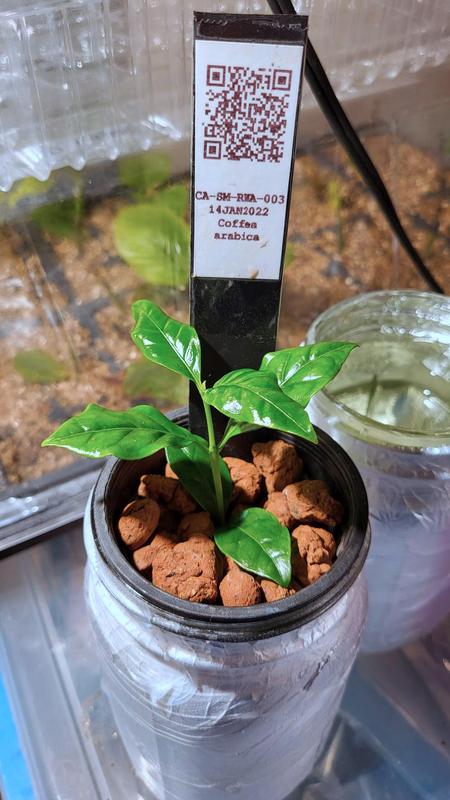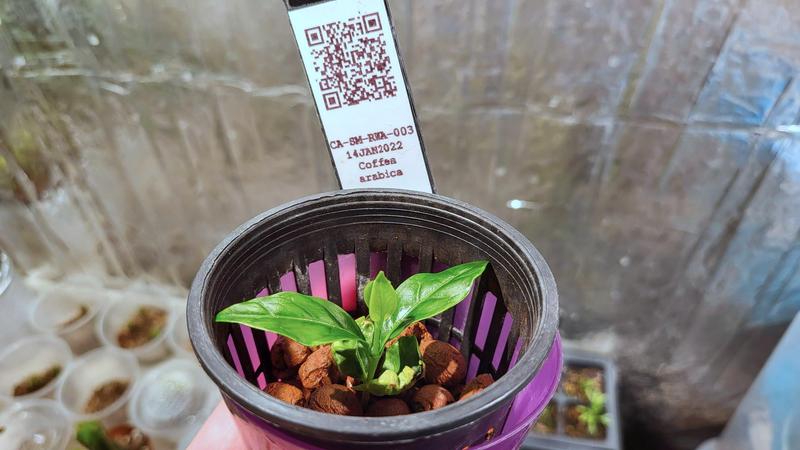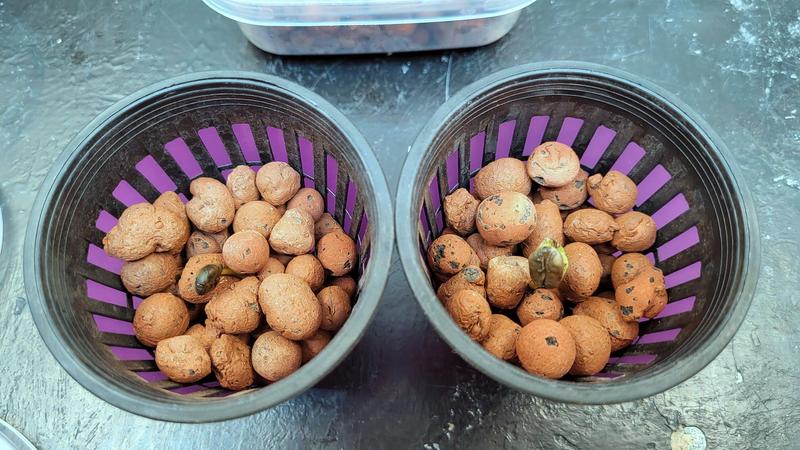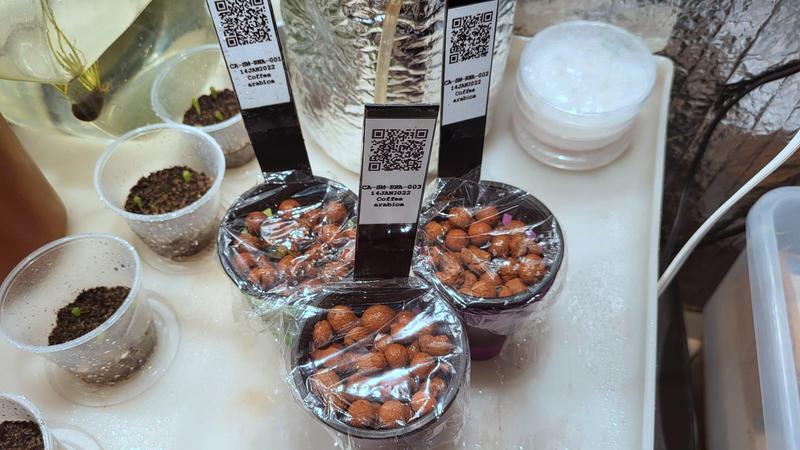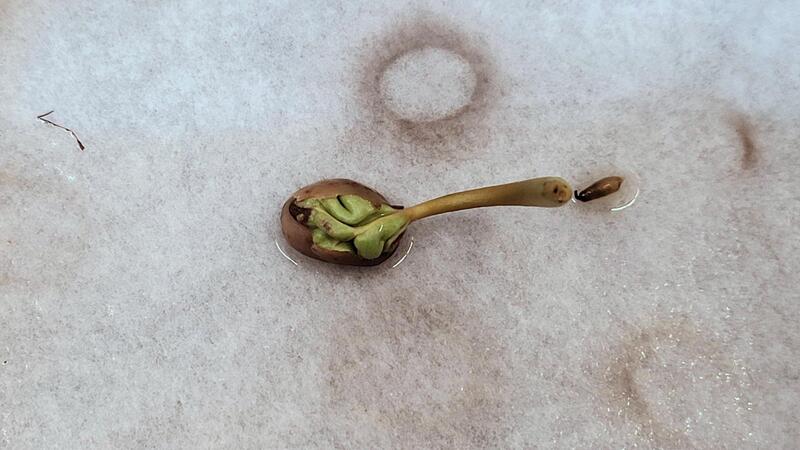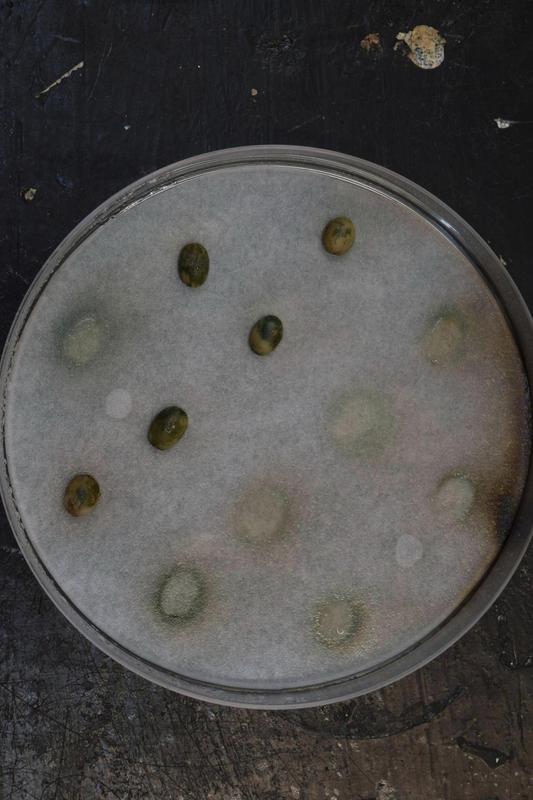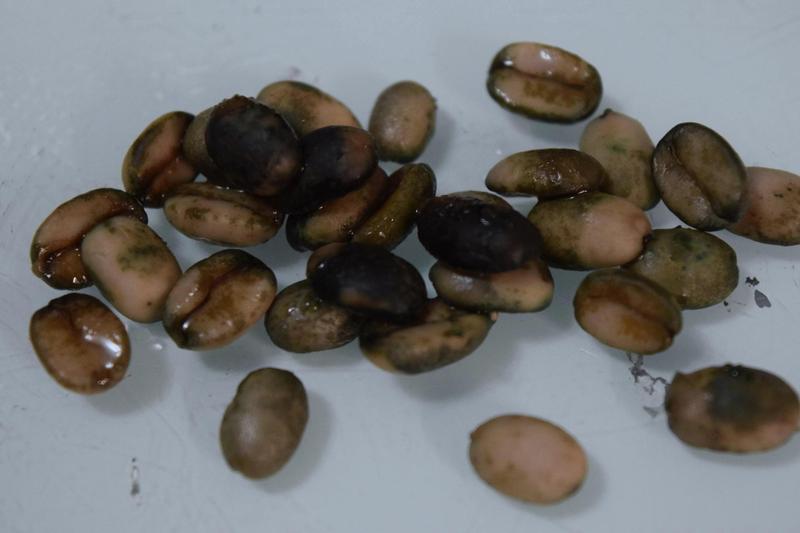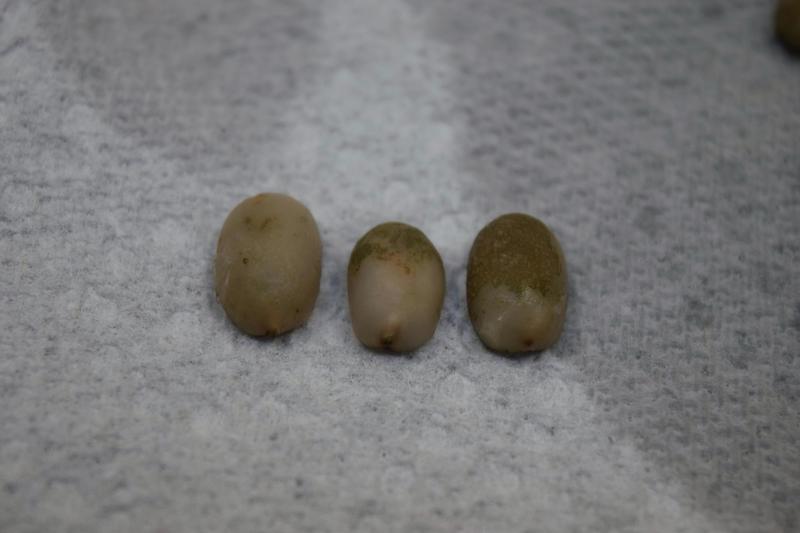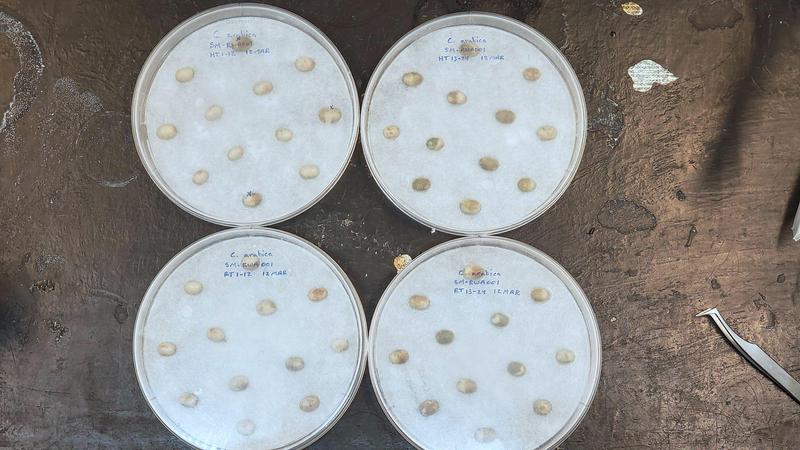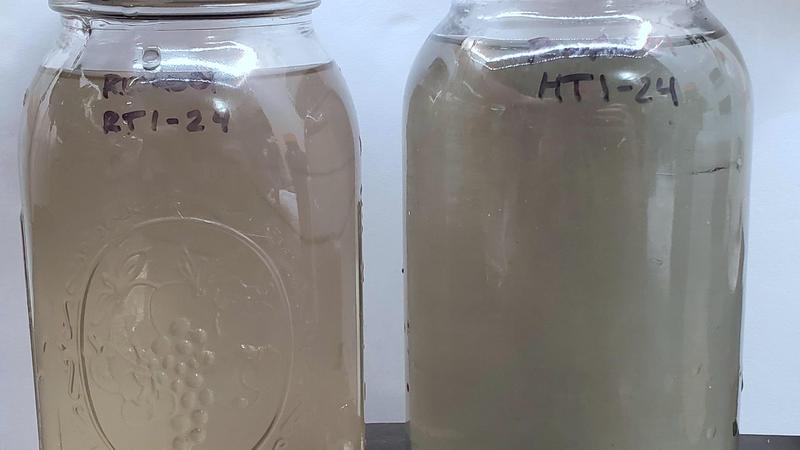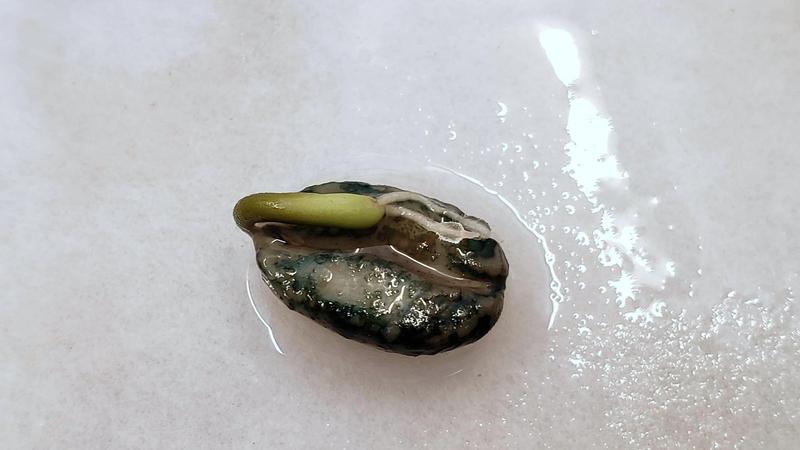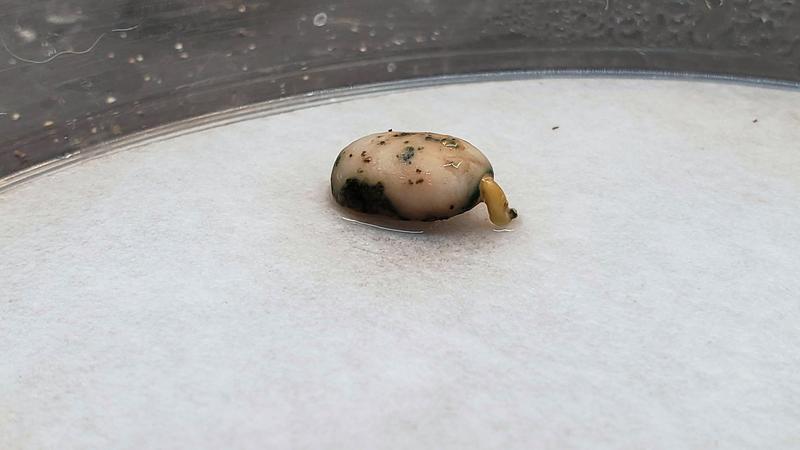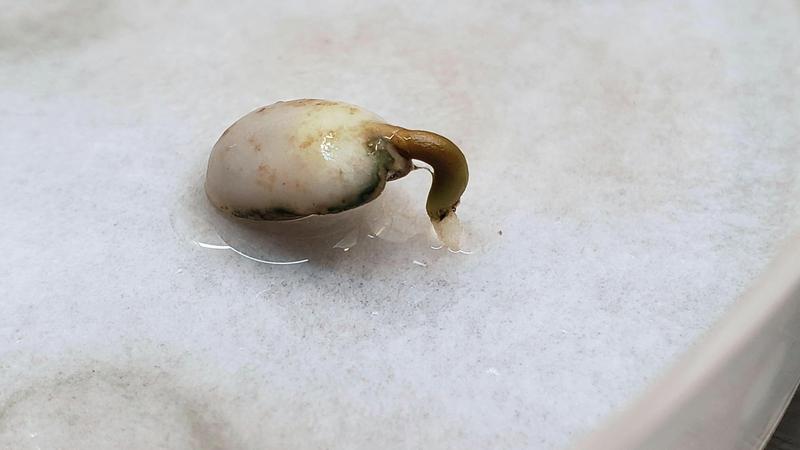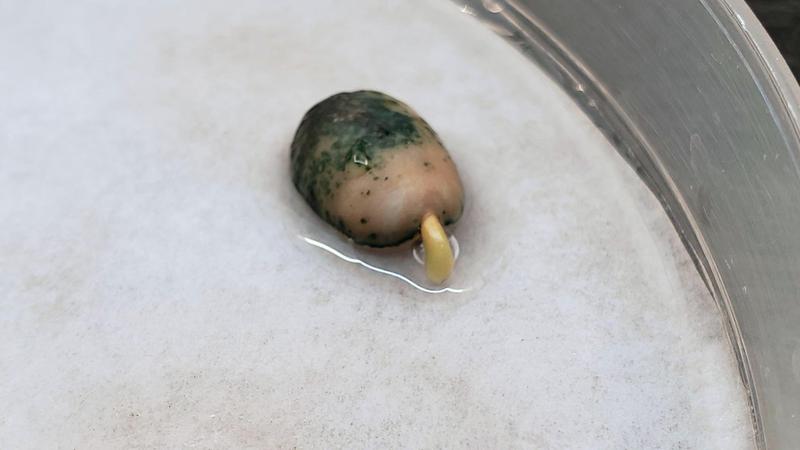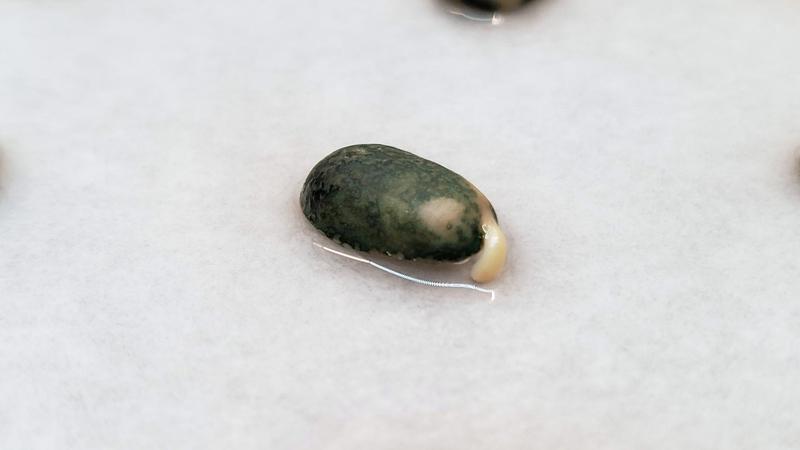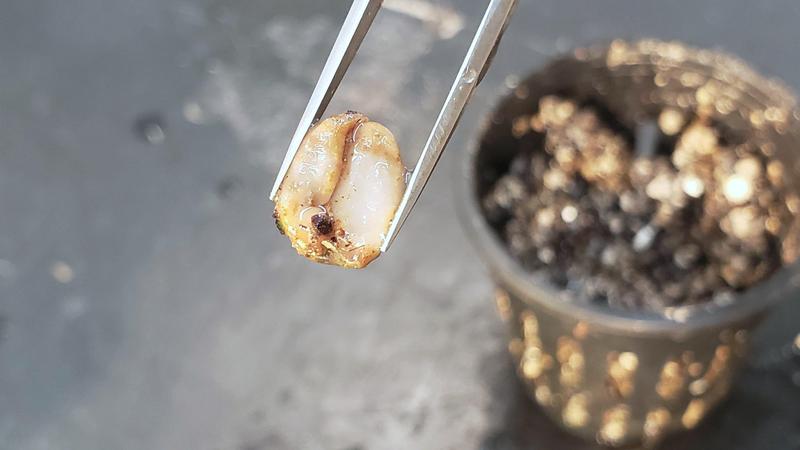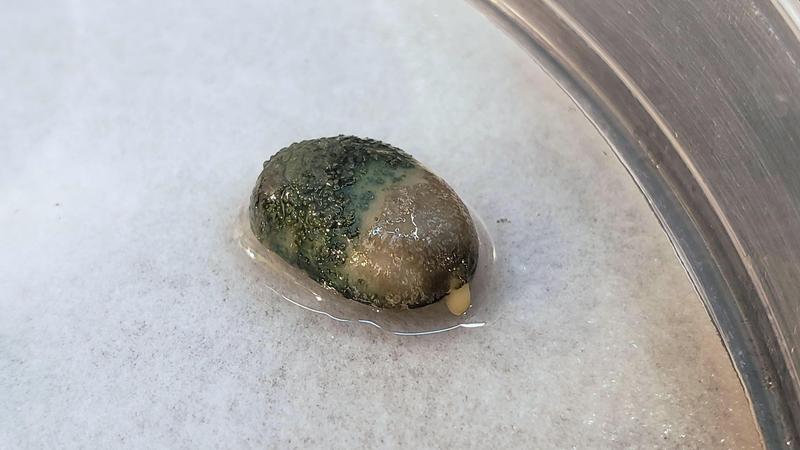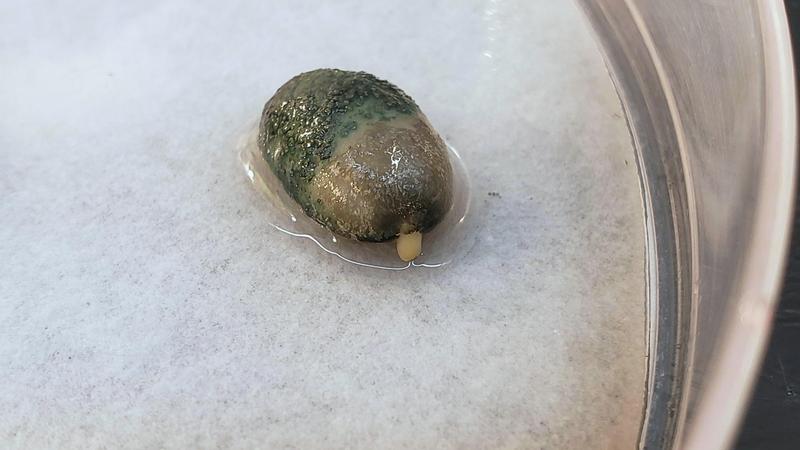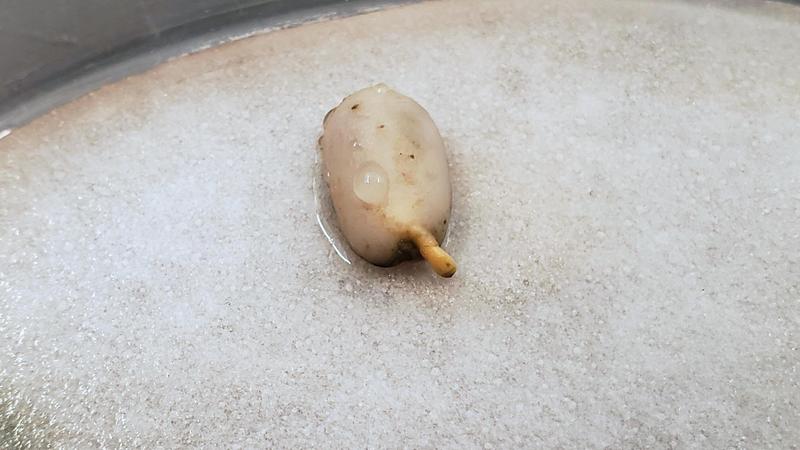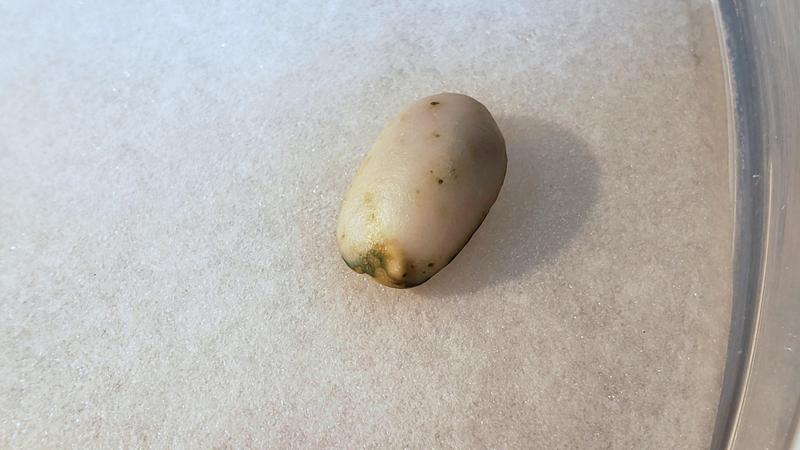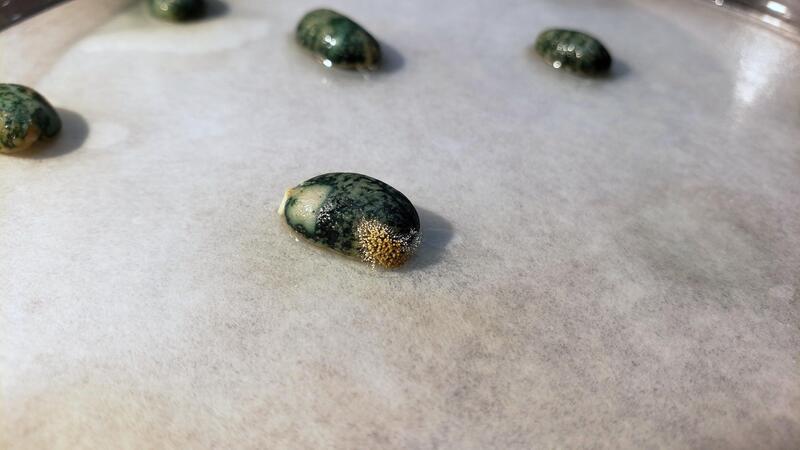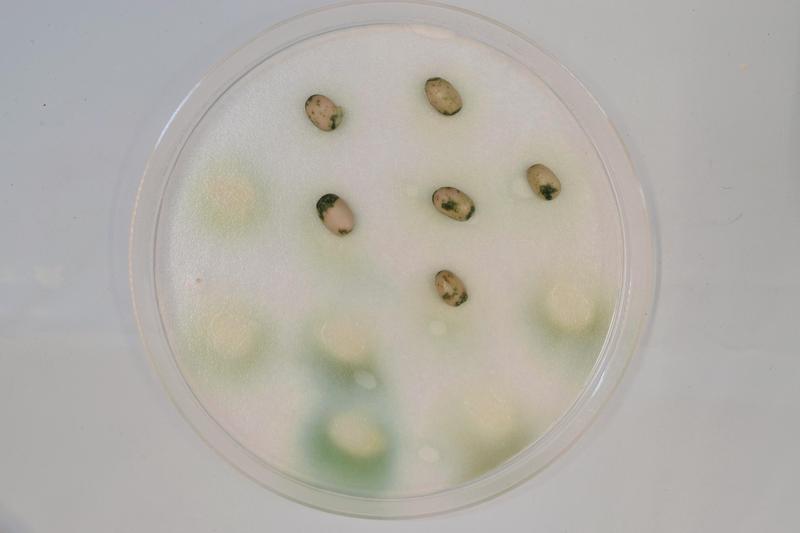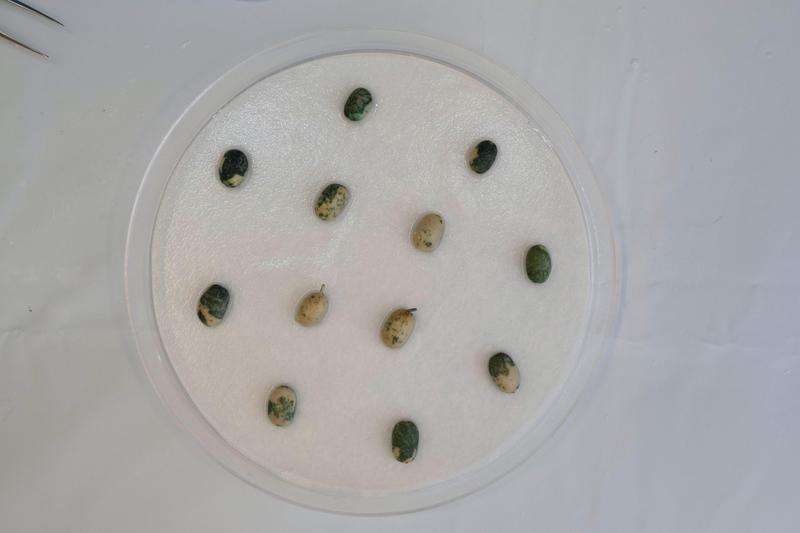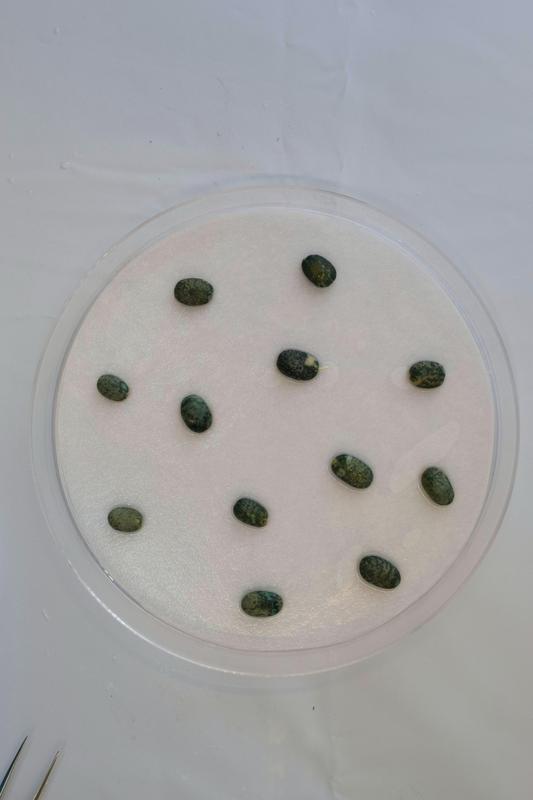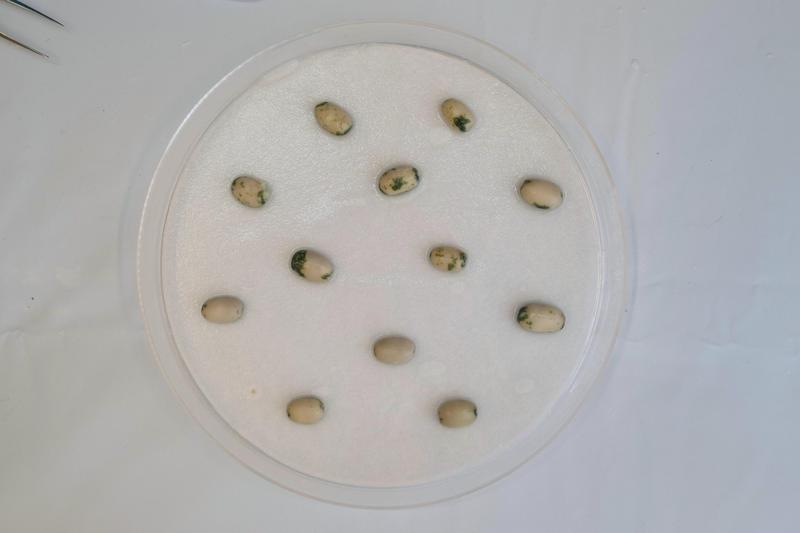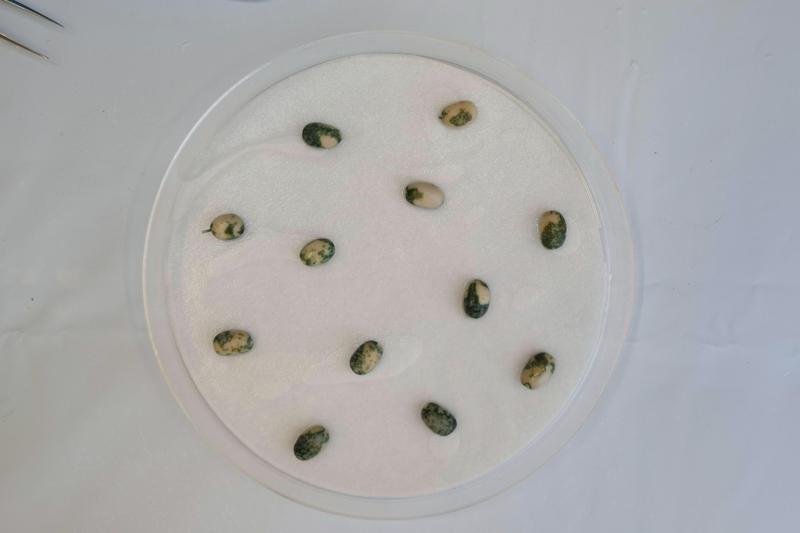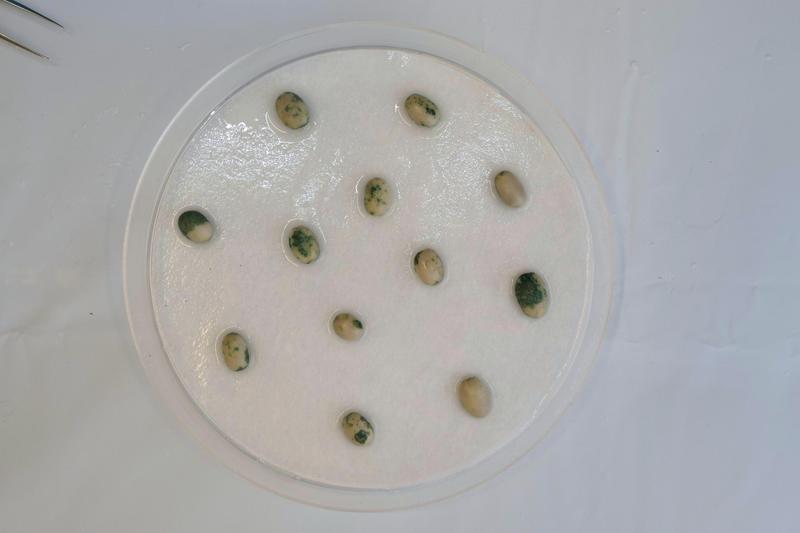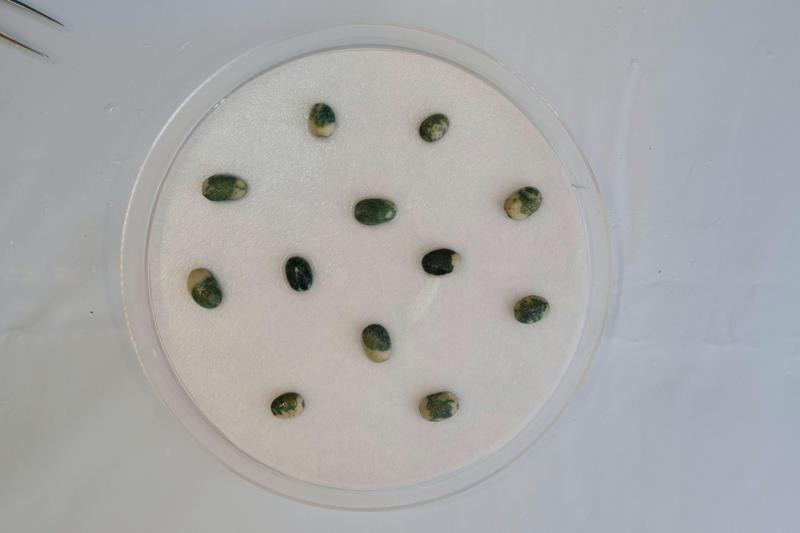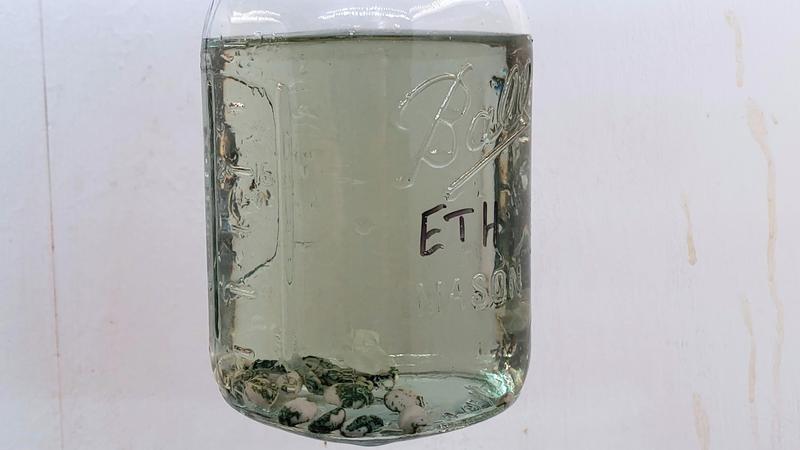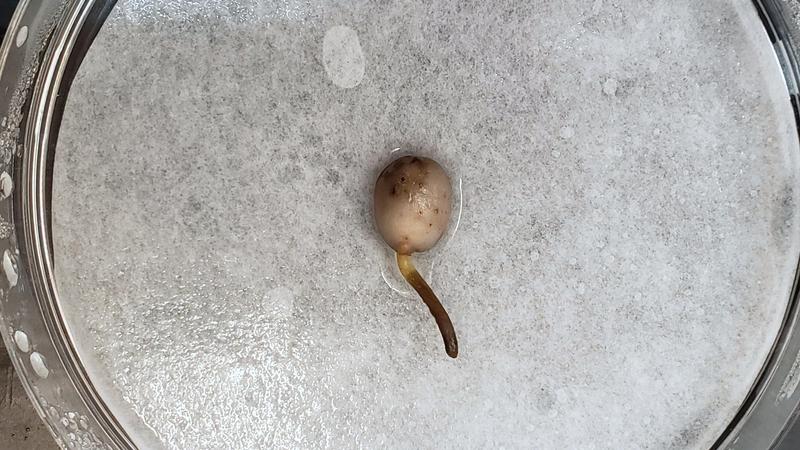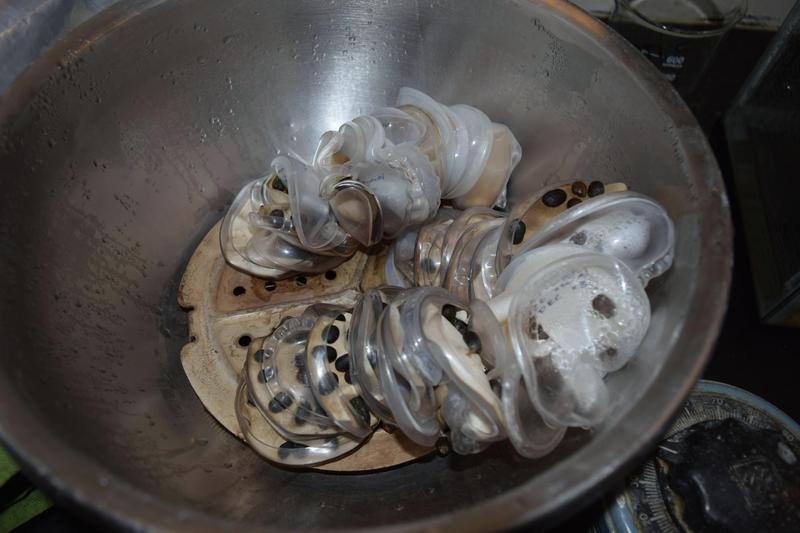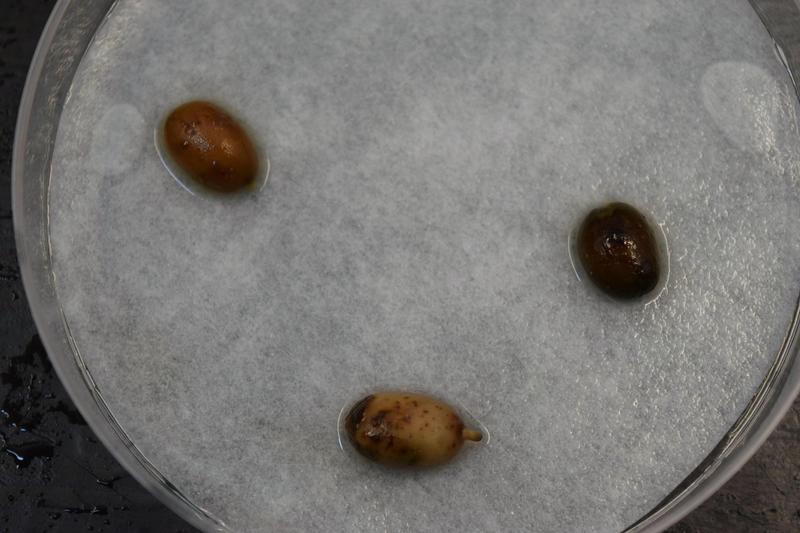Coffea arabica
Videos
Propagation
Germination
| media | germination | temperature °C | note | reference |
|---|---|---|---|---|
Wet-processed coffee may have had the germination process started and subsequently aborted.[1]
Although that depends a lot on the individual differences in processing at each coffee farm, especially the quality control selection processing.[2][3]
Although short periods of fermentation have been used in the literature for seed germinating studies with good results.[4]
Soaking seeds in 4% active chlorine for 3 hours prior to sowing can increase the emergence speed and growth rate. Higher concentrations can negatively impact the embryo.[5]
In general, the results of this work attest to the feasibility of using pre-imbibition of coffee seeds in aqueous solution, containing sodium hypochlorite at a concentration of 4% chlorine active. The use of this treatment promoted percentage increase and emergence speed of seedlings in relation to seeds with parchment.(google translated)[5]
Commercial coffee is typically dried to around 11-12% moisture content.
Properly stored, coffee seeds can maintain viability for many months if not years.[4][6]
Perhaps imbibition serves dual purposes: To hydrate the dried seeds and to dilute the caffeine and other allelopathic compounds. Exogenous caffeine can inhibit the germination and early growth of coffee seeds.[7] Unfortunately, hydrophobic complexes in the cuticular layers of the seed prevent caffeine from leaching during germination.[6]
This might limit the number of seeds per petri dish. Baumann and Gabriel used five seeds per petri dish.[6]
Ideal germination temperature is 25-27°C.[6]
Shipping does not seem to impact viability although no details were given on the method.[8]
Three days of water soaking is sufficient to reach a plateau (phase II of imbibition). In the same experiment, radicle protrusion occurred at an average of 10 days. After two weeks, the seeds gained additional weight indicating phase III.[8]
In-tact parchment might have a lower incidence of infection by fungi.[9]
A 200ppm gibberellic acid solution can increase the vigor of coffee seeds. Soaking in hot water damages seeds.[10]
Seeds are formed in nodes produced in the previous growing season.[11]
Boron is immobile in the coffee phloem. Foliar B spray can correct deficiencies present at the time of leaf growth.[11]
Foliar sprays of boron, zinc, and copper can be used on coffee with mixed results. Any two of the ions seem to be beneficial in either foliar or solid trunk injection, but all three simultaneously return to control values.[11]
The majority of commercial green coffee beans are infected with viable Aspergillus and other fungi.[12]
Seedlings planted in conventional beds designed for bare-root transplanting fair significantly better than ball-rooted seedlings grown in bags. However, ball-rooted seedlings are more likely to survive transplantation to a field.[13]
Mechanical scarification to remove the parchment layer speeds germination. Dilute sulfuric and concentrated hydrochloric OTC acids are unable to penetrate the parchment layer and are no different from water-soaking.[14]
Exudates leached onto moistened paper during the imbibition process can indicate seed viability.[15]
30°C is the ideal germination temperature, but not the ideal temperature for seedling vigor.[16]
Coffea does not require a drying process to germinate. They do not possess specific mechanisms for desiccation tolerance. However, some species have machinery that can be adapted to provide some protection.[16][17]
Since seed desiccation tolerance machinery is commonly put in place during late maturation, coffee cherries that would otherwise be considered “over-ripe” might tolerate drying more than “ripe” ones. Certainly, green cherries have less tolerance to drying.[17]
Seed moisture is determined by drying at 105°C for 24 hours.
Radical growth is visible after hydration as a small, whitish spot that grows into a protuberance from one end. Seeds without visible radical growth are the least viable.[18][19]
It seems that aeration is especially important to coffee.
The response of coffee to light differs among mature or young leaves.[20] This might affect earlier research on photoinhibition if the leaf development stage was not standardized between treatments.
Arabica can be grafted onto nematode-resistant canephora rootstocks to confer resistance and increase productivity, with interactions from cultivar and environment.[21]
The rate of drying affects germination ability in canephora, with interactions from final moisture concentration.[22]
Storage tends to increase fungal contamination. Moisture impermeable polystyrene sacks were less likely to be contaminated after storage, hypothetically due to low moisture absorbance from the environment and coffee seed respiration. [23]
Sunscreen/antiperspirant for coffee plants.[24][25]
Coffee greatly benefits from mycorrhizal fungus inoculation, in some cases doubling its growth features.[26]
Discarding the smallest and lightest of seeds results in superior batch seedling viability and vigor. Mechanical separation by density and size is also superior to hand-picking.[27]
Seedlings are remarkably tolerant to waterlogging.[28]
Arabica shares many features of shade-avoiding species. Photoinhibition observed in high-light plants may be due to diffusive limitations on photosynthesis. Arabica is probably best considered to be “shade-tolerant”.[29]
Sand is a better-starting media compared to peat.[30]
Seedlings should be grown in high light, not shade.[31]
Soaking for 72 hours (the maximum tested) results in an improvement in almost all growth parameters and remains significant after 45 days after sowing with some measures persisting beyond 75 days (the end of the study period).[32]
Preheating (soaking in 40°C water for 4 hours) and prehumidification (exposure to water-saturated air at 37°C for 24) preserved the germination of one-year-old seeds.[33][34]
The wet process is better than the dry process for germination. Slow drying in the open air in the sun is better than hot-air mechanical drying.[35]
Large numbers of seeds can be imbibed using aerated chambers to ensure adequate oxygenation and circulation during extensive soaking. The water temperature significantly affects the germination and development of coffee.[36]
Soaking seeds in 2.5% sodium hypochlorite for 3 hours at 25°C can accurately distinguish and determine seed viability. A green color that develops near the embryo or root region indicates a non-viable seed. High viability is noted in seeds that develop a green coloration on other parts or no green at all.[18]
Current Protocol
For commodity green coffee beans likely to have a high microorganism load that requires extended disinfection:
- soak in 40°C water for 4 hours
- wash with soapy water
- disinfect with 70% ethanol for 4 minutes
- disinfect with 25% household bleach for 45 minutes
- rinse with sterile water 3x
- leach in a large amount of water for 3 days at 27°C
- exchange soaking water daily
- sow on filter paper in Petri dishes with 1-2 cm space between seeds
- incubate at 25-27°C with light for up to 90 days
- examine daily to remove any infected seeds
Vegetative
In-Vitro
| basal media | supplements | source | target | note | reference |
|---|---|---|---|---|---|
Cultivation
| Planting density (m-2) | inter-row space (cm) | intra-row space (cm) | note | reference |
|---|---|---|---|---|
Harvest
Yield
| product | source | yield per season (kg/ha) | note | reference |
|---|---|---|---|---|
| product | source | yield per plant | note | reference |
|---|---|---|---|---|
Soilless
Soil
| soil type | pH | C-content % | precipitation | temperature (°C) | altitude (m) | note | reference |
|---|---|---|---|---|---|---|---|
Fertilization
| type | rate | time | note | reference |
|---|---|---|---|---|
An alga (Ascophyllum nodosum) based fertilizer can be used as a foliar spray or soil fertilizer for seedlings.[37]
Temperature
Lighting
| fixture type | photoperiod | illumination | note | reference |
|---|---|---|---|---|
Pests
Ecology
Morphology
Roots
Stem
Leaves
Hypostomatic [38]
Inflorescence
Seeds
Not orthodox or “intermediate” seeds.[39][17]
Great diagrams of seedling emergence.[19]
Phytochemistry
| compound | source | concentration (mg/g dry weight) | note | reference |
|---|---|---|---|---|
Infraspecific Variation
Biosynthesis
Distribution
Timecourse
Improvement
| trait | improvement status | reference |
|---|---|---|
Identification
| variety | description | reference |
|---|---|---|
Inheritance
Methods
| type | note | reference |
|---|---|---|
History & Society
Work Log
22 Sep 2022
Received a Coffea arabica rooted cutting from a trade.
17 Jul 2022
RWA-003 has been moved to a 1-quart mason jar Kraty setup. It has developed its third set of leaves.
25 Jun 2022
RWA-003 has developed some true leaves.
02 Apr 2022
The three germinations from trial 3 (SM-RWA001) have been given official designations: CA-SM-RWA-001, CA-SM-RWA-002, CA-SM-RWA-003. Number 1 is the plant that sprouted first and had hairy roots. The other two were transferred to LECA today.
What a happy coffee seedling family.
31 Mar 2022
One of the seeds has revealed an interesting cotyledon structure.
17 Mar 2022
Removed seeds with significant exudate.
The pile of “dead” seeds.
12 Mar 2022
Three seeds from the high-temp group have (barely) visible light-colored protrusions.
I finally transferred the high-temp trial seeds to Petri dishes in the incubator.
Also transferred one of the trial 3 germinations to sterile LECA. The one with the hairy roots that formed. Used full-strength Masterblend hydroponic nutrient to fill.
10 Mar 2022
Color change difference between high temp and room temp treatments.
08 Mar 2022
Starting a test of high-temp shock. 24 seeds from RWA-001 were soaked in 40°C water for 4 hours. 24 seeds, also from RWA-001, were soaked in room temp water (22°C) at the same time. In both cases, 1 liter of water per 24 seeds.
07 Mar 2022
One of the germinations has developed root hairs. This seems like a good reason to transplant to LECA.
06 Mar 2022
Well I have called it. Only sm-rwa001 seeds have survived. The others have been lost to contamination and discarded.
Three seeds from sm-rwa001 1-12 have germinated. Three or maybe four have germinated from 13-24. So separating by hypochlorite color doesn’t seem to be statistically different.
07 Feb 2022
Roots are progressing, albeit slowly.
I have four total germinations. All of them from the Rwanda coffee.
01 Feb 2022
After investigating the lack of growth in the trial 2 sole survivor, it was revealed that the root was entirely gone.
Fortunately, new germinations have started in trial 3.
30 Jan 2022
24 Jan 2022
Root bulges are starting to occur.
I have only removed one infected seed so far. That’s pretty good.
I think a combination of exudate and bleaching color monitoring is a good combination for viability testing.[18][15]
19 Jan 2022
Removed seeds that left significant discoloration on the filter paper indicating dead, leaky seeds.
18 Jan 2022
Exchanged water.
Sowed seeds onto Petri dishes. 12 seeds per 140mm dish. Two dishes per group.
17 Jan 2022
Exchanged water (t+36 hours; I forgot the first day).
15 Jan 2022
Started 3rd trial.
14 Jan 2022
3 different varieties:
- Rwanda Kivu Kageyo
- SM-RWA001
- GCX-7066-001
- Ethiopia Agaro Duromina
- SM-ETH001
- GCX-7051-001
- Peru Organic Laderas De Cajamarca
- SM-PER001
- GCX-7090-005
I want to try more leaching this time as a variation. During the initial 72-hour soak, I will use quart jars filled with water instead of half-pints with water exchanges every 24 hours. This will hopefully minimize the caffeine allelopathic effect.
- heat treat 40°C 4 hours
- rinse in soapy water
- soak in 70% ethanol for 4 minutes
- rinse
- soak in 25% bleach (~2% sodium hypochlorite) for 45 minutes
All seeds will be incubated at 30°C in the 140mm Petri dishes with filter paper. 12 seeds per 140mm dish.
12 Jan 2022
A new batch of green coffee has arrived. The box sat on my porch for less than two hours and the temperature was about 9°C. Thankfully, the timing was perfect to hit a warm spell. That says nothing about the possible bitter cold these seeds experienced during transit, airplane, or otherwise.
30 Dec 2021
It’s a Christmas miracle! One of the seeds from trial 1 sprouted.
I was discarding the entire trial when I came across it. One seed from sm-gua001 growing in the LECA. Go figure.
27 Dec 2021
Ordered new coffee from Sweet Maria’s. I prioritized new deliveries but didn’t pick any that were dry process or wet-hulled. I have four varieties coming.
05 Dec 2021
Well… all seeds in trial 2 have died. The incubator malfunctioned and cooked them.
A complete loss. Including the 3 newly discovered sprouts.
04 Dec 2021
3 sprouts!
Three seeds from the 2nd batch of Kenya now have protruding radicles. This is strange since, as mentioned before, the Kenya-sourced coffee had so many losses due to infection. No other sprouts were noted.
Although… I may be neglecting crowding effects.
I am not using a larger planting density than some germination studies of coffee. However, I am using a relatively large proportion of dead seeds.
Caffeine is allelopathic and can inhibit germination even in coffee. This usually isn’t a problem since caffeine is tightly bound in the coffee seed. However, when the seed dies, some of that caffeine is released into the media.
The crowded and high percentage of dead seeds in my dishes may have been enough to inhibit the live seeds. When I removed the infected seeds, I also removed some of the caffeine that was inhibiting growth. That could be why only the Kenya coffee is sprouting.
It could also be random luck. Three out of 468 is so rare, that all of them being from a single source is not impossible.
There could also be an effect of temperature variation. Heating from below has some downsides and I noticed that the Kenya plates tend to dry out faster.
30 Nov 2021
Many seeds have been removed from germination conditions since they have been engulfed by fungi. The Kenya source was the worst. An entire dish had to be thrown out and dozens from the others were removed. Mexico and Guatemala sources had far fewer losses.
A considerable number of seeds have turned dark brown or black. These are likely dead, but I will keep them unless they become infected.
I check the first trial daily and water as necessary. Some obvious signs of infection are present, but there is nothing I can do about that now.
21 Nov 2021
Sowed the seeds in 7 Petri dishes for each seed source (6 for one since I ran out). It was a tight fit (~23 seeds per 90mm dish). I separated the seeds that displayed a small protuberance (10-15 seeds from each batch).
The Petri dishes are stacked in my water bath for temperature control. I had to run the bath on 40% power via a variac because the temperature swings would hit 40°C. Now the temp stays steady at 30 +- 1 °C with only 250ml of water at the bottom. I think the bottom of the stack of Petri dishes is warmer than the top, but I don’t have a good solution right now. I need a proper germination chamber.
20 Nov 2021
Exchanged soaking water. I noticed more bubbles and foam than in the last trial.
To increase the temp of the incubation chamber, I set a small space heater at 75F next to the incubator. I should have known that the temp regulator wasn’t exactly perfect. The temp inside the chamber reached more than 30°C before I fixed it.
19 Nov 2021
Exchanged soaking water.
18 Nov 2021
Started a second trial. 160 (154 needed + a few extra) seeds selected from SM-KEN001, SM-GUA001, SM-MEX001. Heat shock at 40°C for 4 hours.
Sterilized in jars instead of nylon bags this time.
- 1 minute in 70% ethanol
- rinse with distilled water
- 20 minutes in 0.6% sodium hypochlorite + tween 20 (standard solution)
15 Nov 2021
I noticed some fungal infections in some of the cells. Perhaps for these seeds, I should have verified the disinfection before sowing. Or maybe those seeds are a lost cause in any case?
The petri dishes had also dried significantly even though there were heavy drops on the lids.
12 Nov 2021
I turned up the heat in my house and added some insulation to the outside of the germination chamber. Everything is working now. Well… except for the therm sensors. Those got disconnected, so I had to shut everything down to fix them. The SHTC3 still doesn’t work, but at least I have temperature control again.
11 Nov 2021
The germination chamber is having trouble reaching the required 26°C temperature. It is, after all, only heated by a single seed starter mat of about 15 watts.
My house is currently around 21°C. If the chamber doesn’t reach the required temp by tonight, I’ll have to do something else. I have relay space to accommodate another heater if necessary.
10 Nov 2021
Planted!
The peat pellets were lost in the mail so I only ended up with 468 seeds sown. I had trouble fitting those into the two 1020 flats, so I guess it is a good thing that’s all I did.
07 Nov 2021
Selected 170 seeds from each of the three bean sets. The selection consisted of removing obvious cracked, malformed, or otherwise damaged seeds. Peaberry seeds were also discarded.
Soaked each batch for four hours at 40°C in tap water each in separate nylon mesh bags. Side note: The water turned green which is probably not a good sign.
Dipped seeds in soapy water with mild agitation (30-35°C).
Dipped seeds in 10% household bleach solution for 30 minutes (30-35°C).
Drip drained seeds. Emptied the bag into sterilized 150ml of distilled water in single-layer filtered 8oz jars. Set for incubation at 26°C for 72 hours. Covered water bath with aluminum foil to block light.
The damn PID controller wouldn’t stabilize so I ended up just using a Buchi water bath. It generally stays within 1°C of the target temperature. My script says that I used a PID controller, but who is going to know? Well… now you do.
Autoclaved media at 15psi for 1 hour. Except for peat pellets which got lost in the mail.
05 Nov 2021
Trials
If we are assuming a 1 in 3 germination rate, we need around 12 seeds to give a better than 99% chance of germination.
Media
- vermiculite
- potting soil (mulch based)
- peat
- coconut coir
- perlite
- sand
- expanded clay
- peat plugs
- rockwool
- flat petri dish
- pleated petri dish
- kraft paper roll
- coffee filter roll
- paper towel roll
Beans
- Guatemala Antigua Finca Cabrejo GCX-6894
- Mexico FTO Comunidad Tierra Blanca Organic GCX-6843
- Kenya Muranga Kangu AB GCX-6887
14 media types 3 bean types 150 groups 504 total seeds
Using 1.5” cell packs for 1020 trays gives 96 cells per tray. Two trays should fit all of the 108 cell-type media and dishes.
06 Oct 2021
Project Created!
Bibliography
- D. Selmar, G. Bytof, S.-E. Knopp, and B. Breitenstein, “Germination of Coffee Seeds and Its Significance for Coffee Quality,” Plant Biology, vol. 8, no. 2, pp. 260–264, Mar. 2006.
doi: 10.1055/s-2006-923845.
Besides genotypic characteristics, the crucial factor that determines coffee quality is the mode of post-harvest treatment, i.e., the wet and dry processing. Up to now, the resulting characteristic flavour differences between these differentially processed coffees were attributed exclusively to differences in starting material. However, as these quality differences are still evident, even when identical coffee samples were processed by the two methods in parallel, the differences must be created by metabolic processes in the coffee beans themselves. Based on expression studies of the germination-specific isocitrate lyase and the resumption of cell cycle activity, monitored by the abundance of β-tubulin, we evidence that germination is initiated in coffee seeds during the course of standard coffee post-harvest treatments. The extent and nature of the germination processes depend on the processing method. The coherence of metabolic events, substantial differences in the chemical composition of the coffee beans, and the generation of specific coffee qualities establishes the basis for a quite novel approach in coffee research.
- T. Owen, “What Is Wet-Processed Coffee? - Sweet Maria’s Coffee Library,” Sweet Maria’s Coffee Library. Nov-2014.
https://library.sweetmarias.com/what-is-wet-processed-coffee/.
You might know it for its clean, bright taste, but wet-processing is a means to get the seed separated from the fruit, get it dried, and prepare it for roasting. Wet-processed coffee means the skin (and pulp) is peeled from the fruit before it is dried.
- T. Owen, “What Is Dry Processed Coffee? - Sweet Maria’s Coffee Library,” Sweet Maria’s Coffee Library. Mar-2020.
https://library.sweetmarias.com/what-is-dry-processed-coffee/.
It takes incredible intention and care to create a premium dry processed coffee.
- A. V. Humberto and H. Goldbach, “Storage of Coffee (Coffea Arabica L.) Seed,” Journal of Seed Technology, vol. 5, no. 2, pp. 7–13, 1980.
https://www.jstor.org/stable/23432818.
Seeds of Coffea arabica, ’Caturra’, were kept under different storage conditions. When sealed hermetically in gas-proof foil packets and stored at 10 C, seeds with 43% moisture content maintained 74% viability for five months. At moisture contents of approximately 31% and 36%, seeds deteriorated much faster. Seeds kept 6 months in "open" storage at 10 C and in an atmosphere of 70 to 90% relative humidity (RH), resulting in a seed moisture content (s.m.c.) of 15 and 23%, respectively, maintained high viability (between 84 and 92%) over six months; whereas, most seeds died at 50% RH (9% s.m.c.) Drying to 6% s.m.c. quickly killed coffee seeds. Surprisingly, some 20-25% of the seeds at 13% s.m.c. survived over six months at -20 C, a temperature thought to be lethal to so-called recalcitrant seeds. Simple classification of seeds as either ’orthodox’ or ’recalcitrant’ does not take into account the more complex storage behavior of species such as coffee.
- V. Sofiatti, E. F. Araujo, R. F. Araujo, A. Cargnin, M. S. Reis, and L. V. B. D. Silva, “Use of Sodium Hypochlorite to Hasten the Emergence and Development of Coffee Seedlings,” Bragantia, vol. 68, pp. 233–240, 2009.
doi: 10.1590/S0006-87052009000100025.
The objective of this study was to evaluate the effect of seed imbibition in water solution at different concentrations of sodium hypochlorite on the rate and speed of emergence of coffee seedlings as well as to assess the development of the seedlings. One trial was conducted for each of the five seed moisture content (13%, 18%, 23%, 28% and 33% wet weight). Each one consisted of five treatments, represented by seeds previously imbibed for three hours in water solution with three sodium hypochlorite concentrations (4, 5 and 6% of active chlorine), besides seeds with parchment and seeds without parchment (control). The seedlings were evaluated for the emergence rate and speed, and the seedlings for height, number of leaves and leaf area. The preimbibition of seeds with initial moisture degree of 23, 28 or 33% in water solution with sodium hypochlorite at 4% active chlorine increased the rate and speed of seedling emergence, and improving the seedling development compared to seeds with parchment.
- T. W. Baumann and H. Gabriel, “Metabolism and Excretion of Caffeine during Germination of Coffea Arabica L.,” Plant and Cell Physiology, vol. 25, no. 8, pp. 1431–1436, Dec. 1984.
doi: 10.1093/oxfordjournals.pcp.a076854.
To investigate the physiological role of the purine alkaloids during germination, seeds of Coffea arabica were allowed to germinate under aseptic conditions on agar at 26°C, either in the dark or in the light. After imbibition for 7 days less than 1% of the seed caffeine is found in the agar, indicating a strong diffusion barrier at the surface of the coffee bean. After 56 days, when the radicle has grown deep into the agar support, a considerable amount (22%) of caffeine is excreted. The total caffeine content increases during germination for 56 days by 83% in the dark and by 51% in the light, whereas the soluble protein falls drastically. We propose that caffeine is not a nitrogen reserve for germination and acts against competitors (release into the soil) and against predators (concentration increase in the tissue).
- J. Friedman and G. R. Waller, “Caffeine Hazards and Their Prevention in Germinating Seeds of Coffee (Coffea Arabica L.),” Journal of Chemical Ecology, vol. 9, no. 8, pp. 1099–1106, Aug. 1983.
doi: 10.1007/BF00982214.
The inhibition of growth of seedlings of coffee (Coffea arabica L.) exposed to 10 m M caffeine was found to occur in the rootlet: mitosis and cell plate formation were also inhibited. Since concentrations of endogenous caffeine in the imbibed seed are 40–60 mM, 4–6 times as high as in the seedlings, we conclude that coffee embryos have specific means of avoiding caffeine autotoxicity. Observations indicate that cell divisions in root tips start only after the latter are pushed away from the caffeine-rich endosperm by elongation of the hypocotyl and maintained through cell elongation. Caffeine is introduced into the embryonic cotyledons mostly after cell division is completed there. Thus, coffee seedlings may avoid autotoxic effects of endogenous caffeine by separation between sites where mitosis is occurring and those where caffeine is stored. This is achieved in root tips by separation is space but in the cotyledons by separation in time. Caffeine is liberated from the tree litter in coffee plantations and eventually will produce autotoxic effects, resulting in some degeneration.
- E. A. A. da Silva, P. E. Toorop, A. C. van Aelst, and H. W. M. Hilhorst, “Abscisic Acid Controls Embryo Growth Potential and Endosperm Cap Weakening during Coffee (Coffea Arabica Cv. Rubi) Seed Germination,” Planta, vol. 220, no. 2, pp. 251–261, Dec. 2004.
doi: 10.1007/s00425-004-1344-0.
The mechanism and regulation of coffee seed germination were studied in Coffea arabica L. cv. Rubi. The coffee embryo grew inside the endosperm prior to radicle protrusion and abscisic acid (ABA) inhibited the increase in its pressure potential. There were two steps of endosperm cap weakening. An increase in cellulase activity coincided with the first step and an increase in endo-β-mannanase (EBM) activity with the second step. ABA inhibited the second step of endosperm cap weakening, presumably by inhibiting the activities of at least two EBM isoforms and/or, indirectly, by inhibiting the pressure force of the radicle. The increase in the activities of EBM and cellulase coincided with the decrease in the force required to puncture the endosperm and with the appearance of porosity in the cell walls as observed by low-temperature scanning electronic microscopy. Tissue printing showed that EBM activity was spatially regulated in the endosperm. Activity was initiated in the endosperm cap whereas later during germination it could also be detected in the remainder of the endosperm. Tissue printing revealed that ABA inhibited most of the EBM activity in the endosperm cap, but not in the remainder of the endosperm. ABA did not inhibit cellulase activity. There was a transient rise in ABA content in the embryo during imbibition, which was likely to be responsible for slow germination, suggesting that endogenous ABA also may control embryo growth potential and the second step of endosperm cap weakening during coffee seed germination.
- F. Lemessa, A. Abera, G. Adunga, and W. Garedew, “Association of Mycoflora with Coffee (Coffea Arabica L.) Beans at Limmu Coffee Plantation, Southwestern Ethiopia,” Plant Pathology Journal, vol. 14, no. 3, pp. 136–141, Jun. 2015.
doi: 10.3923/ppj.2015.136.141.
Coffee (Coffea arabica L.) bean quality can be affected by a number of factors of which storage fungi are one of the major ones. In Ethiopia coffee is a number one export commodity supporting the national economy but there was little information about the association of mycoflora with coffee beans. Therefore, the objective of this study was to assess the associations of mycoflora with coffee seeds and their effect on coffee infection at Limmu Coffee Plantation. The comparison was done using two coffee berry disease resistant selections (74112 and 74110) with and without parchment and with and without surface treatment of coffee beans with 5% sodium hypochlorite and storing under two storage conditions (local cold house and corrugated iron warehouse). Thus, the experiment was laid down as 2×2×2×2 factorial experiment with four replications. The study showed the association of four fungal species (Fusarium spp., Aspergillus spp., Penicillium spp. and Mucor spp.) and some unidentified species in both blotting and agar plating techniques. In general, significantly higher infection percentage was found in coffee seeds without parchment and surface disinfection irrespective of the storage type and coffee selection. Thus, keeping coffee beans with parchment and disinfecting by disinfectants may reduce the association and prevalence of mycoflora on coffee and minimize postharvest problems.
- D. Suhendra, S. Efendi, S. Aisyah, and S. H. Y. Saragih, “Seed Vigor Testing of Coffee [Coffea Sp.] to Gibberellin Hormone [GA3] Concentration and Water Temperature Differences,” in IOP Conference Series: Earth and Environmental Science, 2021, vol. 741, p. 012004.
doi: 10.1088/1755-1315/741/1/012004.
West Sumatra is one producing coffee region in Indonesia that contributes to the economy in Indonesia because unstable need expand. Optimizing generative propagation of coffee plants with gibberellin hormone treatment and different water temperatures on coffee seed germination stage. The research was conducted at the Seed Technology Laboratory Faculty Agriculture, Andalas University from July to September 2020. Research methods used randomized block design [RBD] with 2 treatments namely concentration hormone gibberellin and immersion water temperature differences. Measurement parameters are maximum growth potential [%], First Count Test [FCT] [%], and Index Value Test [IVT] [days]. All parameter observation results showed a significant effect on the treatment of gibberellin hormone concentration and water temperature treatment. G4S1 sample [the combination of 200 ppm gibberellin hormone concentration and room water temperature treatments] has resulted as the best treatment for all parameters. Respectively, 0.79 days for index value test, 76.67% for the first count test, and 85% for the maximum growth potential parameters.
- J. M. Clemente, H. E. P. Martinez, A. W. Pedrosa, Y. Poltronieri Neves, P. R. Cecon, and J. L. Jifon, “Boron, Copper, and Zinc Affect the Productivity, Cup Quality, and Chemical Compounds in Coffee Beans,” Journal of Food Quality, vol. 2018, p. e7960231, May 2018.
doi: 10.1155/2018/7960231.
Micronutrients perform specific and essential functions in plant metabolism, and their deficiency may lead to metabolic disturbances that affect coffee production and quality beverage. In Brazil, the B, Cu, and Zn are the main micronutrients, and these are provided by soil or foliar fertilization, frequently with low recovery efficiency. This work objected verifying the feasibility of supplying of B, Cu, and Zn via insertion of tablets in the orthotropic branch of Coffea arabica, as well as to evaluate the coffee plant response in terms of productivity and quality of the beverage. Adult plants received B, Cu, and Zn, each micronutrient alone or combined with the other two, by foliar fertilization or by tablets inserted in the trunk base. The productivity, cupping quality, and some chemical indicators of beans quality were evaluated in two crop seasons. Boron, copper, and zinc supplied by foliar spray or solid injections in the trunk influenced the chemical composition and quality of the coffee beans, characterized by the cupping test and the levels of caffeine, trigonelline, sucrose, glucose, arabinose, mannose, 3-caffeoylquinic acid, 5-caffeoylquinic acid, polyphenol oxidase activity, and total phenolic compounds. Copper and zinc were equivalent in either form of supply regarding the production and quality of coffee.
- C. Viegas et al., “Fungal Contamination in Green Coffee Beans Samples: A Public Health Concern,” Journal of Toxicology and Environmental Health. Part A, vol. 80, no. 13-15, pp. 719–728, 2017.
doi: 10.1080/15287394.2017.1286927.
Studies on the microbiology of coffee cherries and beans have shown that the predominant toxigenic fungal genera (Aspergillus and Penicillium) are natural coffee contaminants. The aim of this study was to investigate the distribution of fungi in Coffea arabica L. (Arabica coffee) and Coffea canephora L. var. robusta (Robusta coffee) green coffee samples obtained from different sources at the pre-roasting stage. Twenty-eight green coffee samples from different countries of origin (Brazil, Timor, Honduras, Angola, Vietnam, Costa Rica, Colombia, Guatemala, Nicaragua, India, and Uganda) were evaluated. The fungal load in the contaminated samples ranged from 0 to 12330 colony forming units (CFU)/g, of which approximately 67% presented contamination levels below 1500 CFU/g, while 11% exhibited intermediate contamination levels between 1500 and 3000 CFU/g. Contamination levels higher than 3000 CFU/g were found in 22% of contaminated coffee samples. Fifteen different fungi were isolated by culture-based methods and Aspergillus species belonging to different sections (complexes). The predominant Aspergillus section detected was Nigri (39%), followed by Aspergillus section Circumdati (29%). Molecular analysis detected the presence of Aspergillus sections Fumigati and Circumdati. The% coffee samples where Aspergillus species were identified by culture-based methods were 96%. Data demonstrated that green coffee beans samples were contaminated with toxigenic fungal species. Since mycotoxins may be resistant to the roasting process, this suggests possible exposure to mycotoxins through consumption of coffee. Further studies need to be conducted to provide information on critical points of coffee processing, such that fungal contamination may be reduced or eliminated and thus exposure to fungi and mycotoxins through coffee handling and consumption be prevented.
- M. Ibrahim, T. Kufa, and K. Belachew, “Growth Response of Coffee (Coffea Arabica L.) Cultivars to Various Transplanting Methods at Bonga, South Western Ethiopia,” Growth, vol. 5, no. 7, 2015.
https://www.iiste.org/Journals/index.php/JNSR/article/view/21493.
The use of an appropriate transplanting techniques and polythene bags (pot sizes) for cultivars vary from place to place due to lack of information based technology. Therefore, there is a need to determine area specific transplanting techniques for available cultivars. Accordingly, an experiment was conducted to evaluate the growth response of Coffee arabica cultivars to transplanting methods at Bonga South Western Ethiopia, in 2012/2013 cropping season. The first set of experiment encompasses two experiment factors that were two transplanting methods (bare rooted and ball rooted) and six (Coffea arabica L.) cultivars (75227, 741, 7440, Dessu, 74110 and 74112); their factorial combination was tested using randomized complete block design with three replications. Bare root transplanting methods significantly(p<0.05) increase seedling vigor indices at first true leaf, leaf area index (LAI), internodes length, plant height and root volume (RV) and total biomass (TDW) at early growth stage of Arabica coffee seedlings, however it showed lower survival percentage (52.20% ) after field transplanting. On the other hand, Seedling growth parameters; number of leaf, LAI, plant height, stem girth, root volume and TDW were significantly (p<0.05) influenced by arabica coffee genotypes. TDW increases from 2.65 g and 2.65 g/ seedling to 3.51 g and 3.50 g /seedling for 75227 and 741 open Arabica cultivars, respectively, however, open Arabica coffee cultivar (741) was revealed lower field survival percentage (48.83% ) after field transplanting. Generally, coffee seedling grown under ball rooted transplanting methods were found under good growth performance (93.06% ) after field transplanting. Therefore, among the studied Arabica coffee cultivars 7410, 74112, Dessue and 75227 could be recommended to be raised on ball rooted transplanting methods as an agronomical feasible choice for the study area.
- M. Coa Urbaez, J. R. Mendez Natera, R. Silva Acuña, and S. Mundarain Padilla, “Evaluation of chemical and mechanical methods to promote the seed germination and production of match seedlings of coffee (Coffea arabica) var. Catuaí Rojo.,” IDESIA, vol. 32, no. 1, pp. 43–53, 2014.
doi: 10.4067/S0718-34292014000100006.
The experiment was carried out in the open at the Escuela Técnica Robinsoniana Aragua de Maturin, located in the capital of Piar municipality Monagas State in order to evaluate the effect of different coffee seed scarification treatments on germination and formation of match seedlings. Selected coffee seeds of variety Catuai Red from Instituto Nacional de Investigaciones Agrícolas were used. Washed river sand was used as a substrate, it was disinfected with boiling water and put in garden type trays 12 x 40 x 15 cm. The three treatments with mechanical scarification were without water immersion and immersion for 24 and 48 hours, all six treatments employing chemical stratification with battery acid (Copper®) and muriatic acid (Opin®) for 10, 20 and 30 minutes of immersion; moreover, two treatments with immersion in water for 24 and 48 hours and the control treatment was the used one for coffee producer (without scarification and immersion). The experimental design was a randomized complete block with 12 treatments and four replications. The experimental unit consisted of 50 seeds. Evaluations were carried out at 25, 30, 40 and 50 days after sowing (DAS). Treatments where coffee seeds were subjected to mechanical scarification and water immersion for 24 and 48 hours showed the highest values of germination and formation of match seedlings, in which, it was found that over 60% of germination occurred at 25 days and formation of match seedlings occurred at 30 DAS. Chemical scarification treatments using commercial products with muriatic acid and battery acid did not have any advantage in relation to the control.
- P. C. Hilst, D. C. F. dos S. Dias, E. M. Alvarenga, and B. L. de Souza, “Test of Exudates Color Hues for Evaluating the Physiological Potential of Coffee (Coffea Arabica L.) Seeds,” Revista Brasileira de Sementes, vol. 34, no. 2, pp. 212–217, 2012.
doi: 10.1590/S0101-31222012000200004.
Coffee seeds have slow and irregular germination, losing fast their viability during storage, and the standard germination test of these seeds requires at least 30 days. Besides, the results may not reflect the actual physiological quality of these seeds. The objective of this work was to develop a fast and practical test for evaluating the viability of coffee seeds, which is based on the interpretation of different color hues of exudates from seeds. Coffee seeds of the cultivar Catuai 44 from six lots were submitted to germination, accelerated aging, and electrical conductivity tests. In the exudates color hue test, coffee seeds without the parchment and the silvery pellicle (four replications of 10 seeds each) were distributed on top of paper towels moistened and then maintained into a germinator, at 25 ºC for 24, 48, 72, 96, and 120 h. Three classes of color hues were established: colorless, light color hue, and dark color hue, assigning the values of 0, 1, and 3, for each class, respectively. The proposed exudates color hue test can be recommended for the fast assessment of viability for coffee seeds. The most promising results were obtained for seeds with 12% moisture content, after imbibition periods of 72, 96, and 120 h; and with 30% moisture content, after imbibition periods of 72 and 120 h.
- S. D. V. F. da Rosa, A. M. Carvalho, M. B. McDonald, E. R. V. von Pinho, A. P. Silva, and A. D. Veiga, “The Effect of Storage Conditions on Coffee Seed and Seedling Quality,” Seed Science and Technology, vol. 39, no. 1, pp. 151–164, Apr. 2011.
doi: 10.15258/sst.2011.39.1.13.
Obtaining commercially useful coffee seedlings is hindered by slow, uneven germination and low tolerance to desiccation as well as reduced coffee seed longevity. Coffee seeds have been considered recalcitrant, orthodox and even intermediate with varying results. Current recommendations suggest that coffee seeds can be safely stored between 10-11% f.w.b. at 15°C. However, after drying and storage, coffee seeds lose vigour, and seeds stored after drying cannot be used for producing seedlings. Coffee seedling producers usually sow seeds immediately or lightly dry them after harvest for a short storage period, if necessary. It is highly desirable that seeds are stored safely to optimize coffee seedling production at the appropriate time and season with ideal climatic conditions for planting in the field. The objective of this study was to determine the quality of coffee seedlings produced from seeds stored with high, medium and low moisture levels under hermetic conditions at 10 and 20°C. Seed and seedling quality were assessed before and after nine months storage. Only the germination of seeds harvested at the cherry stage, evaluated before and after the storage at 10°C, was not affected by moisture content, but these seeds lost vigour and did not produce suitable seedlings for planting when stored for nine months. Seedlings produced in the nursery from seeds with 47 and 12% moisture content performed the same as those from greenish-yellow seeds, but they produced a leaf area that was five times smaller, a stem height three times shorter, and had 1.7 times fewer pairs of true leaves than coffee seedlings produced from fresh seeds. Storage at 20°C was not suitable for coffee seeds, especially those at 18% moisture content whose quality declined drastically. These results suggest that coffee seeds do not tolerate desiccation and that their storage behaviour classification should be reviewed.
- A. K. Stavrinides et al., “Seed Comparative Genomics in Three Coffee Species Identify Desiccation Tolerance Mechanisms in Intermediate Seeds,” Journal of Experimental Botany, vol. 71, no. 4, pp. 1418–1433, Feb. 2020.
doi: 10.1093/jxb/erz508.
In contrast to desiccation-tolerant ‘orthodox’ seeds, so-called ‘intermediate’ seeds cannot survive complete drying and are short-lived. All species of the genus Coffea produce intermediate seeds, but they show a considerable variability in seed desiccation tolerance (DT), which may help to decipher the molecular basis of seed DT in plants. We performed a comparative transcriptome analysis of developing seeds in three coffee species with contrasting desiccation tolerance. Seeds of all species shared a major transcriptional switch during late maturation that governs a general slow-down of metabolism. However, numerous key stress-related genes, including those coding for the late embryogenesis abundant protein EM6 and the osmosensitive calcium channel ERD4, were up-regulated during DT acquisition in the two species with high seed DT, C. arabica and C. eugenioides. By contrast, we detected up-regulation of numerous genes involved in the metabolism, transport, and perception of auxin in C. canephora seeds with low DT. Moreover, species with high DT showed a stronger down-regulation of the mitochondrial machinery dedicated to the tricarboxylic acid cycle and oxidative phosphorylation. Accordingly, respiration measurements during seed dehydration demonstrated that intermediate seeds with the highest DT are better prepared to cease respiration and avoid oxidative stresses.
- L. S. D. Reis, E. F. Araújo, D. Dias, C. Sediyama, and R. C. Meireles, “LERCAFE: New Test to Estimate the Germination of the Coffee Tree Seeds (Coffea Arabica L.),” 2010.
doi: 10.1590/S0101-31222010000100001.
The use of the LERCAFE test in the fast evaluation of the seeds of coffee, has a low cost and an easy execution and interpretation, allowing estimate accurately and with quickness the potential of germination of the coffee tree seeds, besides presenting non destructive characteristics, favoring the evaluation of seedlings deriving from the tested seeds. With the objective of using the hypochlorite of sodium in the development of a new test to evaluate quickly the quality of the coffee tree seeds, through the estimate of the germination, the present work was accomplished being used four portions of coffee tree seeds (Coffea arabica L.) cv. IAC Catuai 44 and four portions of cv. Rubi. The percentage of germination of the seeds was estimated by the developed test, denominated LERCAFE, in two methodologies. In the method 1, the seeds had its parchment removed manually and soon after they were immersed in solution of hypochlorite of sodium to 2,5%, where they stayed for 3 hours. After that, the seeds were washed and later evaluated visually. In the method 2, the seeds with parchment were immersed in hypochlorite of sodium to 5,0% for a period of 6 hours and the seeds that were submitted to this method were washed and immersed in distilled water by 40 minutes and later appraised. Like this, in the visual evaluation of the seeds, were considered non-germinated the seeds that presented formation of greenish coloration in the embryonic area and the seeds that didn’t present visible embryo; the quality of the portions was also characterized by the germination test. The two methods of the LERCAFE test presented increase correlations with the germination test. The use of the LERCAFE test in the fast evaluation of the seeds of coffee, has a low cost and an easy execution and interpretation, allowing estimate accurately and with quickness the potential of germination of the coffee tree seeds, besides presenting non destructive characteristics, favoring the evaluation of seedlings deriving from the tested seeds.
- L. A. Oliveira et al., “Histochemical Approach of the Mobilization of Reserve Compounds in Germinating Coffee Seeds,” Coffee Science - ISSN 1984-3909, vol. 15, pp. e151704–e151704, Aug. 2020.
doi: 10.25186/.v15i.1704.
The endosperm of coffee beans is an important structure which is composed of different reserve compounds. In the present work, we followed anatomical features during the reserve mobilization of Coffea arabica L. ‘Catuaí’ seed samples, harvested at 20 different sites, after 0, 3, 6, 12, 24, 33 and 45 days of imbibition. Seed samples were properly fixed and stored, respectively, for histochemical and enzyme activity approach. Fixed samples were cross-sectioned for detection of starch, lipids, essential oils, oleoresins, proteins, phenolic compounds, neutral polysaccharides, alkaloids, β-1,3 and β-1,4 glucans, and lignin. Overall, based on histochemical tests and enzyme activity, seed reserve mobilization was similar among the evaluated altitudes and mountainsides. During soaking, there is an intense consumption of reserve compounds, starting at the region close to the embryo. Reserve mobilization intensifies after root protrusion, from 12 days of soaking. The intensification of the reserve consumption is concomitant with an increased activity of MDH is observed at the first 12 days, whereas SOD showed higher expression after 33 days of soaking. At the 33rd day, little reserve is observed in the endosperm. At 45th day, cotyledon leaves are expanded, and the root system, constituted by the taproot and lateral roots, is well established. Key words: Coffea arabica; germination; reserve breakdown; histochemistry; seed anatomy.
- C. Campa et al., “Juvenile Coffee Leaves Acclimated to Low Light Are Unable to Cope with a Moderate Light Increase,” Frontiers in Plant Science, vol. 8, p. 1126, 2017.
doi: 10.3389/fpls.2017.01126.
The understorey origin of coffee trees and the strong plasticity of Coffea arabica leaves in relation to contrasting light environments have been largely shown. The adaptability of coffee leaves to changes in light was tested under controlled conditions by increasing the illumination rate on C. arabica var. Naryelis seedlings acclimated to low light conditions and observing leaf responses at three different developmental stages (juvenile, growing and mature). Only mature leaves proved capable of adapting to new light conditions. In these leaves, different major mechanisms were found to contribute to maintaining a good photosynthetic level. With increased illumination, a high photosynthetic response was conserved thanks to fast nitrogen remobilization, as indicated by SPAD values and the photorespiration rate. Efficient photoprotection was accompanied by a great ability to export sucrose, which prevented excessive inhibition of the Calvin cycle by hexose accumulation. In contrast, in younger leaves, increased illumination caused photodamage, observable even after 9 days of treatment. One major finding was that young coffee leaves rely on the accumulation of chlorogenic acids, powerful antioxidant phenolic compounds, to deal with the accumulation of reactive oxygen species rather than on antioxidant enzymes. Due to a lack of efficient photoprotection, a poor ability to export sucrose and inadequate antioxidant protection, younger leaves seemed to be unable to cope with increased illumination. In these leaves, an absence of induced antioxidant enzyme activity was accompanied, in growing leaves, by an absence of antioxidant synthesis or, in juvenile leaves, inefficient synthesis of flavonoids because located in some epidermis cells. These observations showed that coffee leaves, at the beginning of their development, are not equipped to withstand quick switches to higher light levels. Our results confirm that coffee trees, even selected for full sunlight conditions, remain shade plants possessing leaves able to adapt to higher light levels only when mature.
- F. J. López-García and J. G. Cruz-Castillo, “Yield of Coffea Arabica Grafted onto Coffea Canephora in Soils Infested with Nematodes in Mexico,” Coffee Science, vol. 14, no. 3, pp. 308–314, 2019.
doi: 10.25186/cs.v14i3.
The total of three consecutive years of fruit production was evaluated in six coffee cultivars (Coffea arabica L.) propagated by seed and grafted onto Robusta (Coffea canephora var. Robusta). The plantations were established at 640 m, 920 m, and 1340 m altitude in the central region of the Veracruz State, Mexico. The coffea plants were established in soils naturally infested with nematodes. Grafted plants had higher production than those propagated by seed. Fruit production was higher at 640 m and 920 m than at 1340 m for the two types of propagation. The cultivars Colombia Brote Café and Colombia Brote Verde had the highest fruit yield regardless of the propagation methods; in contrast, Pacamara, had the lowest. The grafted coffee plants that were planted at 1340 m had a yield reduction of 27% in comparison with those at 640 and 920 m. When the Costa Rica 95 variety was grafted, it achieved fruit yield similar to Colombia Brote Verde and Colombia Brote Café. Pacamara produced almost 28% more fruit when it was grafted onto Robusta.
- S. C. P. Posse et al., “Impact of Drying Methods Over the Germinative Potential of Conilon Coffee of Late Maturation,” Coffee Science - ISSN 1984-3909, vol. 14, no. 4, pp. 484–492, Dec. 2019.
http://www.coffeescience.ufla.br/index.php/Coffeescience/article/view/1624.
This study aimed to evaluate the effect of different drying methods (regarding temperature and drying time) over the seed moisture and germination of seeds of Coffea canephora, harvested from genotypes of late maturation. For this end, seeds from selected genotypes were harvested and dried using two different methods: drying at 25 ˚C with natural circulation of air and drying at 35 ˚C with artificial circulation of air. The seeds were evaluated to quantify the loss of moisture content, and their germinative potential was assessed by parameters of germination speed, and the proportion of seedlings with healthy germination originated from them. The results show it is possible to apply different drying methods; using different systems, temperatures and times of exposure; to decrease the moisture content of seeds of C. canephora, from 50% (freshly harvested seeds from genotypes of late maturation, in July) to under 18% (dried seeds). Even if the initial stages of the drying process, while the seeds still present high moisture content, are similar for both methods, the method with artificial circulation of air at 35 ˚C promotes the drying speed and is able to achieve the lower levels of seed moisture using less than half of the time required by method with natural circulation of air at 25 ˚C. This faster moisture removal, however, has negative impacts over the germinative potential of the seeds, which are not observed for seeds subjected to the slow natural drying.
- D. Lilia, N. Damiri, and M. Mulawarman, “Diversity of Contaminants Fungi in Coffee Beans Stored Using Polystyrene and Gunny Sacks in South OKU Regency (Indonesia),” Sriwijaya Journal of Environment, vol. 6, no. 2, pp. 13–19, Sep. 2021.
doi: 10.22135/sje.2021.6.2.13-19.
Robusta coffee is a coffee type found in South OKU Regency in Indonesia, and its storage process is highly susceptible to the growth of various fungal species, including fungi that produce Ochratoxin A (OTA). Therefore, this study aims to examine the fungal contamination contained in storage using polystyrene and gunny sacks for 20 and 30 days. Data were obtained from surveys, interviews, and samples from 30 farmers which stored coffee beans using polystyrene and gunny sacks in May-July 2020. The results showed that the moisture content was higher in storage using gunny sacks than in polystyrene sacks, at 16.94 ± 0.878 % and 15.99 ± 1.33%, respectively. Furthermore, 16 fungal species were present in gunny sack storage, while 14 fungal species were observed in polystyrene sacks. The percentage of OTA-producing fungi A.niger and A.ochraceus in the two stores yielded 100% and 63.3%, respectively
- P. S. O. da Silva et al., “Effects of Calcium Particle Films and Natural Shading on Ecophysiological Parameters of Conilon Coffee,” Scientia Horticulturae, vol. 245, pp. 171–177, Feb. 2019.
doi: 10.1016/j.scienta.2018.10.010.
Conilon coffee (Coffea canephora Pierre ex A. Froehner) is an important agricultural crop in Brazil due to its high economic value. This plant species is sensitive to the effects of high levels of solar radiation and temperature, which could limit its wide cultivation in the Brazilian Northeast region. However, management practices such as shading could increase the feasibility of its cultivation. This study aimed to evaluate the effects of different shading methods and the use of calcium particle films on the conilon coffee ecophysiological parameters in the coastal flatland the State of Sergipe, Brazil. The field experiment was carried out as randomized block design with four treatments: i) Natural shading (intercropping coffee and banana plants), ii) Artificial shading with 10% w/v CaCO3 particle films; iii) Artificial shading with 20% w/v CaO particle films; and iv) and control (without shading), and four replicates. Measurements were performed 7, 21 and 35 days after film application at 9:00 h and 12:00 h. Individual parameters, gas exchange efficiency, chlorophyll a fluorescence and maintenance of film coverage on leaves were evaluated. Artificial shading with particle films promoted greater physiological stability of the coffee plants during diurnal meteorological oscillations as compared to the control, resulting in higher rates of liquid photosynthesis (A), better control on stomatal conductance (gs) and transpiration (E). Improvement was also observed in the plant water use efficiency (WUE and IWUE) and in the reduction of leaf temperature. Calcium particle films were more efficient in providing protection to the photosystems and improving photochemical efficiency and energy conversion for photophosphorylation than natural shading. However, the results were more pronounced at 21 days after film application and more persistent for treatment with 20% CaO film. Therefore, calcium particle films are useful tools to alleviate coffee plants stress under adverse climate conditions.
- S. R. Steiman, H. C. Bittenbender, and T. W. Idol, “Analysis of Kaolin Particle Film Use and Its Application on Coffee,” HortScience, vol. 42, no. 7, pp. 1605–1608, Dec. 2007.
doi: 10.21273/HORTSCI.42.7.1605.
Application of a kaolin-based particle film, Surround WP, was analyzed using glass plates and slides. The kaolin was sprayed on coffee grown in full sun to evaluate physiological responses to this shading technique. Kaolin reduced photosynthetically active radiation and ultraviolet transmission and decreased surface temperatures on glass slides. In the second year of application, photosynthesis of plants sprayed with kaolin was 71% greater than full-sun plants and yields were doubled. Leaf temperature was significantly lower in the kaolin treatment, but stable C isotope ratios, water use efficiency, nodal growth, and specific leaf area were not. The most likely mechanisms for increased yield are increased light transmittance to inner-canopy nodes or greater storage of photosynthate during the first year. Although results from this study suggest there is much promise for improving the performance and yield of coffee with kaolin application, studies with other species have shown inconsistent results. This inconsistency may be linked to variation in application techniques, kaolin coverage and subsequent effects on light transmission, leaf temperature, and physiological function. Thus, reports on physiological performance alone are insufficient to evaluate the use of kaolin application. Detailed information on application techniques combined with measurements of end-product criteria such as yield or quality are recommended to facilitate cross-study comparisons.
- A. J. Fonseca, A. F. de Freitas, G. R. Carvalho, M. A. C. Carneiro, D. J. M. Vilela, and L. de O. Fassio, “Arbuscular Mycorrhizal Fungus on the Initial Growth and Nutrition of Coffea Arabica L. Genotypes,” Ciência e Agrotecnologia, vol. 43, Aug. 2019.
doi: 10.1590/1413-7054201943006919.
The benefits of mycorrhization occur with the growth of hyphae in colonized roots by promoting an increase of the contact surface which improves the initial growth due to a better absorption of water and nutrients. The objective was to evaluate the effect of arbuscular mycorrhizal fungus Rhizophagus clarus inoculation over the initial development and nutritional response of six genotypes of Coffea arabica L. Six genotypes of Coffea arabica L. were used (MGS Aranas, H29-1-8-5, Red Catuai IAC 144, IPR 100, Catigua MG2, Paraíso H 419-1) and with arbuscular mycorrhizal fungus - AMF: Rhizophagus clarus and without the application of the fungus. For the production of coffee seedlings, seeds were placed to germinate in plastic trays with sterile sand. After germination, 10 seedlings of each genotype were transferred to 0.120 dm3 polyethylene tubes with substrate. Then the inoculation of five seedlings of each genotype with the AMF R. Clarus was performed. When the seedlings with and without inoculation with the AMF presented six pairs of leaves they were transplanted to 13-liter pots containing soil (Dystrophic red-yellow latosol). The inoculation favored the initial growth of the coffee plants and its intensity varied according to the genotypes. The genotypes H 29-1-8-5, Red Catuai IAC 144 and Catigua MG 2 were the ones that presented higher shoot dry mass, root dry mass, total dry mass and accumulation of P, in relation to MGS aranãs, Paraiso H 419-1 and IPR 100, so they are the most promising to be inoculated with the arbuscular mycorrhizal fungus.
- G. S. Giomo, J. Nakagawa, and P. B. Gallo, “Beneficiamento de sementes de café e efeitos na qualidade fisiológica,” Bragantia, vol. 67, pp. 1011–1020, Dec. 2008.
doi: 10.1590/S0006-87052008000400025.
The objective of this research was to obtain more suitable information concerning coffee seed processing in the air-screen machines and gravity table, studying their effects on the physiological seed quality. One coffee seed lot of the Yellow Catuaí IAC 62 cultivar was processed in a precleaner machine, in an air-screen cleaner and in a gravity table, working in several sequences and combinations, according to technical recommendations for seed processing. The seeds were evaluated as to their physiological quality by the germination test, accelerated aging test, seedling emergence, height and weight of dry matter of seedlings and young plants. The seed moisture was determined at the beginning of the evaluations. The statistical design was randomized blocks with four replications. Mean comparisons were done by the Tukey test at 5 % of probability. It was concluded that: a) physiological seed quality was improved by specific equipments in the several phases of processing, with the best seed quality, obtained with complete operational sequence, where the lot was submitted to the action of the air-screen cleaner and gravity table; b) the gravity table, associated with air-screen cleaner, was effective in removing debris from the seed lot, improving the physiological seed quality; c) larger or denser seeds had superior physiological performance than small sizeor lowdensity seeds, and the large pea berry seeds presented physiological quality similar to the large flat seeds; d) discart of smallest or lightest seeds to improved the physiological seed quality, resulting in homogeneous, and high quality seed lots, and more vigorous young plants.
- H. R. de O. Silveira, M. D. O. Santos, J. D. Alves, K. R. D. de Souza, C. A. Andrade, and R. G. M. Alves, “Growth Effects of Water Excess on Coffee Seedlings (Coffea Arabica L.),” Acta Scientiarum. Agronomy, vol. 36, no. 2, p. 211, Apr. 2014.
doi: 10.4025/actasciagron.v36i2.17557.
The objective of the present study was to evaluate the interference of water excess in soil on the growth of young coffee plants of the Mundo Novo and Catuaí cultivars.Plants were subjected to the following three different substrate water availability conditions: control (wellwatered), continuous substrate waterlogged, and intermittent substrate waterlogged. Several growthrelated traits were evaluated over the course of 19 weeks. Based on the number and quality of the affected variables from all forms of analyses, the Catuaí cultivar showed greater sensitivity to waterlogging. Both cultivars exhibited growth inhibition in response to substrate waterlogging stress, which was exacerbated by premature leaf dropping.
- N. F. Rodríguez-López et al., “Morphological and Physiological Acclimations of Coffee Seedlings to Growth over a Range of Fixed or Changing Light Supplies,” Environmental and Experimental Botany, vol. 102, pp. 1–10, Jun. 2014.
doi: 10.1016/j.envexpbot.2014.01.008.
Acclimations to low and high light levels are located in opposite extremes. We examined how the coffee plant (Coffea arabica), which is considered to be shade-demanding although it performs well under full sun exposure, can acclimate to a range of light regimens. We hypothesised that the growth and physiological performance depends on the total amount of light received by the plant per day and on the temporal order of diurnal variations in the light supply. The biomass accumulation and allocation and the key photosynthetic traits of pot-grown coffee seedlings were examined over a range of light treatments as follows: plants grown entirely under 100%, 40% or 10% sunlight; plants grown at either 40% or 10% sunlight from sunrise to midday and then submitted to full sunlight until sunset; and plants grown under full sunlight from sunrise to midday and then submitted to either 40% or 10% sunlight throughout the afternoon. The total biomass increased linearly with the increasing total light supply; however, plants receiving high amounts of light in the morning grew more than those receiving high amounts of light in the afternoon. Extensive morphological changes (e.g., specific leaf areas and leaf area ratios) primarily responsive to total light rather than diurnal light fluctuations or light quality, at a given light supply, were noted. In contrast, changes in the photosynthetic performance per unit leaf area among the treatments were narrower and apparently unrelated to carbohydrate accumulation or photoinhibition. Overall, we found a poor leaf-level physiological plasticity of traits to light. We suggest that adjustments in leaf number and leaf area, coupled with whole-plant physiological adjustments, could largely account for the differences in the biomass amongst treatments. We also suggest that coffee could be classified as a shade-tolerant species as its traits do not match the requirements of either a classic shade-avoiding or a classic shade-demanding species.
- V. Ortiz-Timoteo, V. M. Ordaz-Chaparro, A. Aldrete, E. Escamilla-Prado, G. Sánchez-Viveros, and R. M. López-Romero, “Pregerminative treatments in seeds of two species of the Coffea genus.,” Agroproductividad, vol. 11, no. 4, pp. 68–73, 2018.
https://core.ac.uk/download/pdf/249320115.pdf.
Coffee seeds have slow and asynchronic germination, which increases the time needed to obtain seedlings, and the expenses associated. A pregerminative treatment (PT) was defined which decreases the germination time in seeds of Coffea arabica L. var. Colombia and Coffea canephora P. var. Robusta. Five pregerminative treatments in water were applied to seeds without endocarp: T1) immersion for 24 hours; T2) scraping plus immersion for 24 hours; T3) immersion for one hour at 40 °C; T4) immersion for 48 hours; and T5) scraping plus immersion for 48 hours. Subsequently, they were sown in two substrates (sand and peat-moss). The treatments had three replicates with 25 seeds as experimental unit, organized into a completely randomized design with factorial arrangement. The variables evaluated were: days to start of germination (DIG), speed of emergence (VE), and percentage of emergence (PE). In Coffea arabica, the PT that decreased the germination period was T1, obtaining seedlings at 22 days, with greater vigor with a VE of 0.55 emerged seedlings per day, and increased PE to 59, 92, and 97% on days 30, 40, and 50, respectively. In Coffea canephora, T1 presented 0.40 VE and PE of 42% at 30 days and 73% at 50 days, while T2 increased PE at 40 and 50 days by 70 and 81%, respectively. The best substrate was sand, which decreased the germination period of Coffea arabica and Coffea canephora to 26 and 23 days, increased VE to 0.53 and 0.35 emerged seedlings per day, respectively, and had PE of more than 70% after 50 days in both species.
- G. A. B. K. Moraes, A. R. M. Chaves, S. C. V. Martins, R. S. Barros, and F. M. DaMatta, “Why Is It Better to Produce Coffee Seedlings in Full Sunlight than in the Shade? A Morphophysiological Approach,” Photosynthetica, vol. 48, no. 2, pp. 199–207, Jun. 2010.
doi: 10.1007/s11099-010-0025-4.
The coffee plant is native to shaded environments and its seedlings are often produced in shaded nurseries. However, some nursery managers, in an effort to improve the acclimation of seedlings to field conditions after transplantation, produce seedlings in full sun exposure. In this study, the morphological and physiological parameters of arabica coffee (Coffea arabica) seedlings produced in full sun (T1) and in shade (T2) were examined. The biomass accumulation and relative growth rate of T1 and T2 seedlings were similar. The T1 seedlings had less biomass allocation to shoots, a lower leaf mass ratio and a lower leaf area ratio; however, they had a greater net assimilation rate (rate of increase in plant mass per unit leaf area), which was associated with a greater net photosynthetic rate. There were no alterations in the concentrations of total chlorophylls or in the chlorophyll a/b ratio when comparing T1 and T2 seedlings. No indications of photoinhibition or photooxidative damage were observed in the T1 plants, which were shown to have a more robust antioxidant system than the T2 plants. Seedlings transferred from shade to full sun (T3) were not capable of utilising the incident extra light to fix CO2. These seedlings showed a remarkable nocturnal retention of zeaxanthin and a significantly increased deepoxidation state of the xanthophyll cycle, even at predawn, but the activity of antioxidant enzymes was lower than in the T1 and T2 plants. Despite the acclimation capacity of T3 seedlings to the new light environment, they exhibited chronic photoinhibition and considerable photooxidative damage throughout the seven days following the transfer to full sun exposure. We further discuss the practical implications of producing coffee seedlings in full sunlight and under shade.
- W. Gebreselas, A. Mohammed, and A. Netsere, “Pre-Sowing Treatment of Coffee (Coffea Arabica L.) Seeds to Enhance Emergence and Subsequent Growth of Seedlings,” Research Journal of Seed Science, vol. 3, no. 4, pp. 218–226, Apr. 2010.
doi: 10.3923/rjss.2010.218.226.
Nursery experiment was conducted to investigate the effect of removal of parchment and soaking of coffee seeds in pure water for different durations on emergence and early growth of coffee seedlings. A split plot design of three replications was employed with seed types (seeds with parchment and clean coffee) and soaking hour (soaking seeds for 12, 24, 36, 48, 60 and 72 h and control) in pure water were assigned as main and sub-plot, respectively. Emergence of seedlings was significantly (p<0.01) affected by coffee seed type (clean coffee vs. coffee with in parchment) where better emergence response was obtained from clean coffee. Forty five, 75 and 90 days after sowing 18.46, 56.70 and 84.70% emergence was obtained from clean coffee, respectively while only 1.86, 15.40 and 49.41% emergence was obtained in the same period, respectively, from coffee seeds sown in parchment. Better emergence occurred from seeds soaked in water against non-soaked ones 45 and 60 days after sowing. Moreover, leaf area and total dry matter weight differed in response to different soaking hours. The seedling vigor index also showed a statistical difference (p<0.01) between coffee seed types where clean coffee resulted in higher value (313.13) over the parchment coffee (232.48). The same parameter resulted from coffee seeds soaked for 72 h was better (p<0.05) when compared to non-soaked seeds and seeds soaked for less than 72 h. The study revealed removing parchment and soaking coffee seeds in water enhances emergency and subsequent growth of coffee seedlings.
- S. Dussert, N. Chabrillange, J.-L. Montillet, J.-P. Agnel, F. Engelmann, and M. Noirot, “Basis of Coffee Seed Sensitivity to Liquid Nitrogen Exposure: Oxidative Stress or Imbibitional Damage?,” Physiologia Plantarum, vol. 119, no. 4, pp. 534–543, 2003.
doi: 10.1046/j.1399-3054.2003.00197.x.
Two hypotheses, namely the occurrence of post-thaw oxidative stress or imbibitional damage, were tested to explain the high sensitivity of coffee seeds to liquid nitrogen (LN) exposure. Oxidative stress was studied by measuring primary and secondary products of lipid peroxidation in seeds during the desiccation and rehydration periods. The 4-hydroxynonenal (4-HNE) content of seeds remained constant throughout the desiccation step. No significant difference was observed between desiccated seeds and seeds desiccated and exposed to LN for the evolution of their 4-HNE and hydroperoxide contents during rehydration. In both cases, an increase in 4-HNE and hydroperoxide contents of seeds was observed during the first hours of culture under germination conditions, followed by a progressive decrease down to values comparable to those observed in desiccated seeds. The hydroperoxide composition of frozen seeds was not significantly different from that of control seeds. The (S)/(R) enantiomeric ratios of 9- and 13-hydroxy-octadecadienoic acid extracted from rehydrating seeds were chiral, suggesting that they originated from lipoxygenase activity. These results suggest that the high sensitivity of coffee seeds to LN exposure is not directly associated with the occurrence of an oxidative stress during post-thaw rehydration. The effect on seed viability of different rehydration procedures previously identified to reduce membrane imbibitional injury was studied after desiccation and LN exposure. Desiccation tolerance increased with, by increasing order, seed osmoconditioning, pre-heating and pre-humidifying prior to their culture under germination conditions. Among the four combinations of pre-humidification durations (24 or 48 h) and temperatures (25 or 37°C) tested, pre-humidification for 24 h at 37°C gave the highest level of desiccation tolerance. This rehydration procedure also dramatically increased seed viability after LN exposure. Seed desiccation sensitivity modelling in combination with the calculation of the decrease in seed water activity during cooling facilitated the explanation of the beneficial effect of controlled rehydration after desiccation and LN exposure. These results support the hypothesis that imbibitional membrane damage is involved in the sensitivity of coffee seeds to LN exposure.
- S. Dussert, \relax M. W. Davey, A. Laffargue, S. Doulbeau, R. Swennen, and H. Etienne, “Oxidative Stress, Phospholipid Loss and Lipid Hydrolysis during Drying and Storage of Intermediate Seeds,” Physiologia Plantarum, vol. 127, no. 2, pp. 192–204, 2006.
doi: 10.1111/j.1399-3054.2006.00666.x.
The biochemical and physiological basis of intermediate seed storage behaviour was examined by investigating the effects of equilibrium drying under relative humidities (RHs) of 9–81% and of storage at 20 or 5°C on coffee seed viability and antioxidant, lipid and sugar status. Slow drying induced a significant decrease in the concentrations of the pools of two major antioxidants, glutathione and ascorbate, and an increase in the free fatty acid (FFA) content of seeds, independent of the RH employed. Seeds stored at 81% RH and 20°C lost their viability very rapidly and showed an extensive loss and oxidation of antioxidants, an accumulation of FFA and a selective loss of phospholipids, in particular phosphatidylethanolamine (PE). Interestingly, the changes in PE content were not due to fatty acid de-esterification and the increase in FFA levels resulted from neutral lipid hydrolysis. Decreasing the storage temperature to 5°C considerably slowed both the loss of seed viability and the level of oxidative stress as well as the rates of lipid hydrolysis. No decline in seed viability was observed under storage conditions of 45% RH/20°C. After 1 year under 45% RH/5°C, the loss of seed viability was found to be due to imbibitional damage and could be circumvented by pre-humidifying or pre-heating seeds before sowing.
- J. H. D. S. Taveira et al., “Post-Harvest Effects on Beverage Quality and Physiological Performance of Coffee Beans.,” African Journal of Agricultural Research, vol. 10, no. 12, pp. 1457–1466, 2015.
http://www.alice.cnptia.embrapa.br/handle/doc/1039291.
During coffee drying, different temperatures applied to the beans with varied humidity content levels can interfere in the membranes integrity, germination, organic acid and carbohydrate content resulting in coffees with distinct flavors. The quality control of the beans will be much more effective the earlier the alterations provoked in the postharvest are detected. This work has an objective to study alternative methods for the dehydration o f the coffee beans using ultra-drying followed by slow drying and its impact on the sensorial quality, chemical composition and physiology. For that purpose, coffee lots were processed by the methods, dry (natural coffee) and wet (fully washed coffee); and sun-dried and machine-dried at a constant 60°C temperature and alternating 60/40°C. The sensory quality of the samples was assessed by the Specialty Coffee Association of America (SCAA) analysis protocol. The sugar, total titratable acidity and the phenolic compound content was also analyzed. The physiological alterations of the coffee beans were analyzed by germination tests, emergence speed index, electrical conductivity and potassium leaching. The temperature of the drying air significantly altered the sensorial quality of the coffee beans. The processing way associated to drying methods causes many physiological alterations with the highest damage observed in the natural coffees. For the first time, we are showing that drying with heated air at 60/40ºC is promising for the fully washed coffee beans, which are more tolerant to dehydration than the natural coffee beans. Conversely, the natural coffee beans were much more sensitive to drying regardless the temperature, with very low performance in the physiological analyses. The drying at the constant 60ºC temperature is inappropriate for the natural coffee as well as for the fully washed coffee beans. In addition, the physiological tests used were shown effective for the early evaluation of coffee beans quality.
- S. M. P. Lima, R. M. Guimarães, J. A. Oliveira, and M. das G. G. C. Vieira, “Efeitos de tempos e temperaturas de condicionamento sobre a qualidade fisiológica de sementes de cafeeiro (Coffea arabica, L.) sob condições ideais e de estresse térmico,” Ciência e Agrotecnologia, vol. 28, pp. 506–514, Jun. 2004.
doi: 10.1590/S1413-70542004000300004.
Objetivou-se com a presente pesquisa estudar tempos e temperaturas mais adequadas para o condicionamento fisiológico e avaliar os efeitos desses tratamentos na germinação sob condições de estresse térmico, de sementes de cafeeiro armazenadas. O estudo foi conduzido nos Laboratórios de Análise de Sementes e Técnicas Moleculares do Departamento de Agricultura da Universidade Federal de Lavras, utilizando-se sementes de café da cultivar Acaiá do cerrado. As sementes foram colhidas nos campos de produção da UFLA e armazenadas em condições de ambiente de agosto/2000 a janeiro/2001, quando foram submetidas ao condicionamento em água nas temperaturas de 15, 25 e 35ºC por 4, 8 12 dias de embebição. O condicionamento foi realizado em câmara tipo BOD, na presença de luz, e a aeração foi feita com compressores e bombas de aquário. Após cada tratamento, as sementes foram imediatamente submetidas à determinação do teor de água e avaliadas pelos testes de germinação e índice de velocidade de germinação sob estresse térmico (20 e 35ºC) e eletroforese de enzimas. Para comparação, foram utilizadas sementes sem tratamento de embebição. Pelos resultados, conclui-se que as sementes condicionadas em água a 15 e 25ºC apresentaram melhor desempenho da germinação em condições de estresse térmico; o condicionamento a 35ºC não foi apropriado; o condicionamento por 4 dias foi o menos eficiente em melhorar a qualidade fisiológica das sementes, e o condicionamento fisiológico em água mostrou-se eficaz ao revigoramento, principalmente a 25ºC por 12 dias.
- W. L. Moreira and R. Ferraz-Almeida, “Development of Coffee Seedlings with Biostimulants,” Coffee Science, vol. 16, pp. e161896–e161896, Oct. 2021.
doi: 10.25186/.v16i.1896.
The production of sustainable coffee (Coffea sp.) has become an alternative to add value to coffee production, reaching new world markets and increasing the farmer’s profitability. Biostimulants have been presented as a tool to increase coffee production. The hypothesis is that the use of biostimulants improves the germination rate and the development of coffee seedlings. This study aims to compare and evaluate the application of biostimulants in the initial development of coffee seedlings. An experiment was carried out in Monte Carmelo, Minas Geras. Applications of biostimulants (i) 4-indole-3-ylbutyric acid + gibberellic acid + cinetina, AIA+AG+C; (ii) foliar fertilizer + algae, F+A; (iii) vegetal extracts + gibberellic acid, EV+AA were carried out on coffee seedlings. After 94 days of applying the biostimulants, monitored the length of the aerial part, the number of leaves, stem diameter, root biomass (pivoting, auxiliary and total). Results showed that the application of F+A promoted the greatest length of the aerial part, the number of leaves, and biomass of the roots. The application of AIA+AG+C showed the same performance as F+A in the number of leaves of the coffee seedlings. Given the results, we concluded that the application of biostimulants based on mixed foliar fertilizer + algae demonstrated to be a better alternative to increase the development of the aerial and root part of coffee seedlings. Key words: Coffea sp.; Organomineral; Root system; Phytohormones.
- E. Arias-Pérez, C. A. Lecona-Guzmán, F. A. Gutiérrez-Miceli, J. A. Montes-Molina, and N. Ruiz-Lau, “Encapsulation of Immature Somatic Embryos of Coffea Arabica L. for in Vitro Preservation,” Phyton, vol. 90, no. 6, p. 1741, 2021.
doi: 10.32604/phyton.2021.016004.
The present study aimed to develop a protocol for somatic embryogenesis and encapsulation of coffee embryos (Coffea arabica L.), for the conservation of genotypes with characteristics of commercial interest. Somatic embryos were induced from leaf explants in Murashige and Skoog medium (MS) supplemented with 1 mg · L −1 of 2,4-dichlorophenoxiacetic acid (2,4-D) combined with 2 mg · L −1 of benzyladenine (BA). Somatic embryos (SE) at the globular stage were encapsulated in a sodium alginate matrix; two treatments were tested: MS + 5 mg · L −1 BA + 1 mg · L −1 NAA + 3% (w/v) alginate, and MS + 7 mg · L −1 BA + 5.7 mg · L −1 indoleacetic acid (IAA) + 3% (w/v) alginate. Alginate was complexed with 100 mM calcium chloride (CaCl 2 ). Viability of the encapsulated SE was determined by staining with 0.01% fluorescein diacetate (FDA) after 0, 15, 30, and 45 days of storage at 4°C. Embryo viability was 100% in both treatments.
- R. Sinício, “Longevity equation for coffee seeds (Coffea arabica L.).,” Engenharia na Agricultura, vol. 19, no. 4, pp. 287–297, 2011.
doi: 10.13083/1414-3984.v19n04a01.
The objective of this study was to develop an equation to estimate longevity of coffee seeds using the Probit Model. Published survival curves of coffee seeds, stored under different temperatures and moisture contents, were transformed to probit and used in linear and non-linear multiple regressions to determine the coefficients of viability equations. The results showed adequate fitting in a quadratic model with a standard deviation of 8.9% germination, compared to 15.1% in the traditional model. The non-linear regression compared to the multiple linear regression, gave lower (1.5 to 2.2 times) standard deviation to determine the coefficient of the equation of the standard deviation of distribution frequency of dead seed during the storage period (σ). The coffee seeds did not behave as orthodox seeds, as indicated by the non linear variations of the logarithm of σ as a function of the variations of the logarithm of the seed moisture content.
